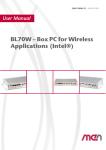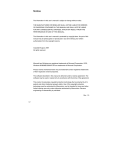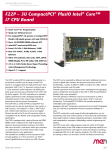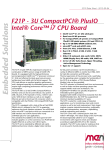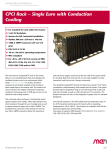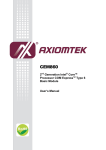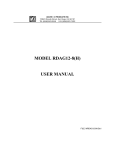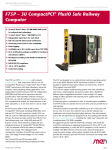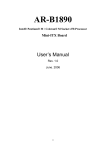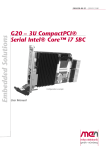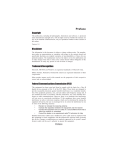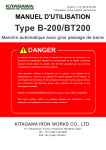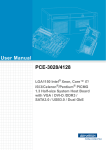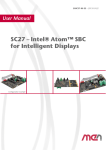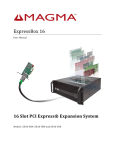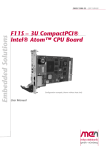Download 2nAxxxxyy Ez User Manual - Diamond Point International
Transcript
20F021P00 E4 – 2015-01-13
User Manual
F21P – 3U CompactPCI®
PlusIO Intel® Core™ i7
CPU Board
F21P - 3U CompactPCI® PlusIO Intel® Core™ i7 CPU Board
F21P - 3U CompactPCI® PlusIO Intel® Core™ i7 CPU Board
The F21P versatile 4HP/3U single-board computer is a continuation of MEN's
proven range of Intel® CPU boards. It is equipped with the high-performance
second generation Intel® Core™ i7 processor running at 2.1 GHz and offering the
latest quad core processor architecture from Intel® with full 64-bit support. The
CPU card delivers an excellent graphics performance and is designed especially for
embedded systems which require high computing performance with low power
consumption.
The F21P offers a 32-bit/33-MHz CompactPCI® bus interface and can also be used
without a bus system. 4 USB 2.0 ports, 4 PCI Express® x1 links, 2 SATA 3 Gb/s and
2 SATA 6 Gb/s interfaces as well as one Gigabit Ethernet are led to the J2 rear I/O
connector which is compatible with the PICMG 2.30 CompactPCI® PlusIO
specification.
The F21P is equipped with fast DDR3 DRAM which is soldered to the F21P to
guarantee optimum shock and vibration resistance. An mSATA disk and a
microSD™ card device which are connected via a USB interface and a SATA
channel offer nearly unlimited space for user applications.
The standard I/O available at the front panel of F21P includes graphics on a VGA
connector, two PCIe®-driven Gigabit Ethernet as well as two USB 2.0 ports.
The F21P can be extended by different side cards. Additional functions include a
digital video interface for flat panel connection via DVI (multimedia), a variety of
different UARTs or another four USBs, SATA for hard disk connection and HD
audio.
Thermal supervision of the processor and a watchdog for the operating system
complete the functionality of the F21P. As an option, a TPM (Trusted Platform
Module) chip can be assembled.
The F21P operates in Windows® and Linux environments as well as under real-time
operating systems that support Intel®'s multi-core architecture. The InsydeH2O™
EFI BIOS was specially designed for embedded system applications.
Equipped with Intel® components exclusively from the Intel® Embedded Line, the
F21P has a guaranteed minimum standard availability of 7 years.
The F21P is suited for a wide range of industrial applications, e.g. for monitoring,
vision and control systems as well as test and measurement. Main target markets
comprise industrial automation, multimedia, traffic and transportation, aerospace,
shipbuilding, medical engineering and robotics.
The F21P comes with a tailored passive heat sink within 4 HP height. The robust
design of the F21P make the board especially suited for use in rugged environments
with regard to shock and vibration according to applicable DIN, EN or IEC industry
standards. The F21P is also ready for coating so that it can be used in humid and
dusty environments.
MEN Mikro Elektronik GmbH
20F021P00 E4 – 2015-01-13
2
Diagram
Diagram
ECC DDR3 SDRAM
Intel® Core™ i7
PCIe x1
ECC DDR3 SDRAM
microSD
mSATA
USB 2.0
USB 2.0
B
SATA
Side Card
SATA (3Gb)
B
VGA
F
F
F
HD Audio
USB 2.0
HDMI
USB 2.0
HDMI/SDVO
PCIe x1
B
J1
cPCI
PCIe/PCI bridge PCI
R
F
Gb Ethernet
F
Gb Ethernet
PCIe x1
PCIe x1
Instead of one rear interface
QM67
Platform
Controller Hub
PCIe x1
PCIe x1
SATA (3 Gb)
F
Front connector
SATA (6 Gb)
R
Rear I/O connector
PCIe x1
B
Onboard connector
MEN Mikro Elektronik GmbH
20F021P00 E4 – 2015-01-13
Gb Ethernet
Instead of one front interface
USB 2.0
Options
Gb Ethernet
J2
Rear I/O
SGPIO
R
3
Technical Data
Technical Data
CPU
• Intel® Core™ i7-2715QE
- Up to 2.1 GHz processor core frequency
- 3 GHz maximum turbo frequency
• Chipset
- Intel® QM67 Platform Controller Hub (PCH)
Memory
• Up to 6 MB last level cache integrated in i7
• Up to 16 GB SDRAM system memory
- Soldered
- DDR3 with ECC support
- 1066/1333/1600 MHz memory bus frequency
• 64 Mbits boot Flash
• Serial EEPROM 2kbits for factory settings
Mass Storage
• microSD™ card interface
- Connected via one USB port
• mSATA disk slot
- Connected via one SATA channel
• Serial ATA (SATA)
- Four channels via rear I/O, one channel via side-card connector, one channel
for mSATA disk
- 4 SATA 3 Gbit/s interfaces, 2 SATA 6 Gbit/s interfaces (rear I/O)
- RAID level 0/1/5/10 support
Graphics
• Integrated in QM67 chipset
- 650 MHz graphics base frequency
- 1.2 GHz graphics maximum dynamic frequency
• VGA connector at front panel
• Two digital display interface ports available via side-card connector
- DisplayPort®, HDMI and SDVO (SDVO only on one interface)
- One additional DVI connector at front panel optional via side card
- Simultaneous connection of two monitors
MEN Mikro Elektronik GmbH
20F021P00 E4 – 2015-01-13
4
Technical Data
I/O
• USB
- Two USB 2.0 ports via Series A connectors at front panel
- Four USB 2.0 ports via side-card connector
- Four USB 2.0 ports via rear I/O
- One USB for connection of microSD
- UHCI implementation
- Data rates up to 480 Mbit/s
• Ethernet
- Two 10/100/1000Base-T Ethernet channels at the front
- RJ45 connectors at front panel
- Ethernet controllers are connected by two x1 PCIe® links
- Onboard LEDs to signal activity status and connection speed
- One 10/100/1000Base-T Ethernet channel via rear I/O
- Ethernet controller is connected by one x1 PCIe® link
• High Definition (HD) audio
- Accessible via side-card connector
Front Connections (Standard)
• VGA
• Two USB 2.0 (Series A)
• Two Ethernet (RJ45)
Rear I/O (PICMG 2.30)
• Four SATA
• Four USB
• One Gigabit Ethernet (second rear interface instead of one front interface as an
assembly option)
• Four PCI Express® x1 links
• Compatible with PICMG 2.30 CompactPCI® PlusIO
- 1PCI33/4PCIE5/2SATA3/2SATA6/4USB2/1(2)ETH1G
Miscellaneous
• Board controller
• Real-time clock, buffered by a GoldCap or alternatively a battery (5 years life
cycle)
• Watchdog timer
• Temperature measurement
• One user LED
• Reset button
MEN Mikro Elektronik GmbH
20F021P00 E4 – 2015-01-13
5
Technical Data
PCI Express
• Three x1 links to connect local 1000Base-T Ethernet controllers
- Data rate 250 MB/s in each direction (2.5 Gbit/s per lane)
• Four x1 links via rear I/O
- Data rate up to 500 MB/s in each direction (5 Gbit/s per lane)
• Three x1 links for extension through side-card connector
- Data rate up to 500 MB/s in each direction (5 Gbit/s per lane)
CompactPCI® Bus
• Connection via PCI Express® link from processor using PCI-Express-to-PCIBridge
• Compliance with CompactPCI® Core Specification PICMG 2.0 R3.0
• System slot
• 32-bit/33-MHz CompactPCI® bus
• V(I/O): +3.3V (+5V tolerant)
Busless Operation
• Board can be supplied with +5V only, all other voltages are generated on the
board
• Backplane connectors used only for power supply
Electrical Specifications
• Supply voltage/power consumption (board versions with i7-2715QE processor)
- +5V (-3%/+5%), 9.6 A typ., 14.4 A max.
- +3.3V (-3%/+5%), 1.8 A (3 Gb Ethernet), 1.4 A (2 Gb Ethernet), 1 A (1 Gb
Ethernet)
- +12V (-10%/+10%), approx. 10 mA
- If the board is supplied with 5V only (typically without a bus connection), the
3.3V are generated on the board and fed to the backplane (3A max.) No
external 3.3 V voltage may be applied in that case!
Mechanical Specifications
• Dimensions: conforming to CompactPCI® specification for 3U boards
• Front panel: 4HP with ejector
• Weight: 204 g (w/o heat sink)
MEN Mikro Elektronik GmbH
20F021P00 E4 – 2015-01-13
6
Technical Data
Environmental Specifications
• Temperature range (operation):
- Depends on system configuration (CPU, hard disk, heat sink...)
- Maximum: +85°C
- Minimum: -40°C (all processors)
- Conditions: airflow 1.5m/s, typical power dissipation: 12 W (board versions
with i7-2715QE processor) with Windows® XP operating system and 1 Gb
Ethernet connection
• Temperature range (storage): -40..+85°C
• Relative humidity (operation): max. 95% non-condensing
• Relative humidity (storage): max. 95% non-condensing
• Altitude: -300m to + 2,000m
• Shock: 50 m/s², 30 ms
• Vibration (Function): 1 m/s², 5 Hz – 150 Hz
• Vibration (Lifetime): 7.9 m/s², 5 Hz – 150 Hz
• Conformal coating on request
MTBF
• 417,879 h @ 40×C according to IEC/TR 62380 (RDF2000)
Safety
• PCB manufactured with a flammability rating of 94V-0 by UL recognized
manufacturers
EMC
• Tested according to EN 55022 (radio disturbance), IEC 61000-4-3
(electromagnetic field immunity), IEC 61000-4-4 (burst) and IEC 61000-4-6
(conducted disturbances)
BIOS
• InsydeH2O™ UEFI Framework
Intel® Active Management Technology
•
•
•
•
Manageability Engine in Chipset
Network Filters in Chipset
Dedicated Flash Storage Area
Out of Band (OOB) Access
- Power off Access
- Independent of OS status
- Power status control
- Keyboard-Video-Mouse (KVM) Viewer (VNC-compatible)
- IDE-Redirect
- Serial-over-LAN
MEN Mikro Elektronik GmbH
20F021P00 E4 – 2015-01-13
7
Technical Data
Software Support
• Note that 64-bit hardware technology can be used in an optimal way with 64-bit
operating system support
• Windows
• Linux
• VxWorks® (on request)
• QNX® (on request)
• Intel® Virtualization Technology, allows a platform to run multiple operating
systems and applications in independent partitions; one computer system can
function as multiple "virtual" systems
For more information on supported operating system versions and
drivers see Downloads.
MEN Mikro Elektronik GmbH
20F021P00 E4 – 2015-01-13
8
Configuration Options
Configuration Options
CPU
•
•
•
•
•
•
•
•
•
Intel® Core™ i7-2715QE, 2.1 GHz, 6 MB Cache, 45 W
Intel® Core™ i7-2655LE, 2.2 GHz, 4 MB Cache, 25 W
Intel® Core™ i7-2610UE, 1.5 GHz, 4 MB Cache, 17 W
Intel® Core™ i5-2515E, 2.5 GHz, 3 MB Cache, 35 W
Intel® Core™ i3-2340UE, 1.3 GHz, 3 MB Cache, 17 W, no AMT
Intel® Core™ i3-2310E, 2.1 GHz, 3 MB Cache, 35 W, no AMT
Intel® Celeron® B810E, 1.6 GHz, 2 MB Cache, 35 W, no AMT
Intel® Celeron® 847E, 1.1 GHz, 2 MB Cache, 17 W, no AMT
Intel® Celeron® 827E, 1.4 GHz, 1.5 MB Cache, 17 W, no AMT
Memory
• System RAM
- Up to 16 GB
• microSD™ card
- 0 MB up to maximum available
• mSATA disk
- 0 MB up to maximum available
Graphics
• One DVI-D connector at front via side card
- Simultaneous connection of two monitors
I/O
• Ethernet
- 9-pin D-Sub connector with one or two 10/100Base-T ports instead of two
RJ45 connectors
- Second Ethernet at rear I/O connector J2 instead of one interface at the front
• Rear I/O
- VGA on CompactPCI® J2 connector as an assembly option for the
conduction-cooled board version
- VBATT on CompactPCI® J1 connector as an assembly option for the
conduction-cooled board version
Miscellaneous
• TPM (Trusted Platform Module) chip assembled as an option
Mechanical
• Side card can be added at left or right side of CPU
MEN Mikro Elektronik GmbH
20F021P00 E4 – 2015-01-13
9
Configuration Options
Operating Temperature
• Depends on system configuration (CPU, hard disk, heat sink...)
• Maximum: +85°C
• Minimum: -40°C (all processors)
Cooling Concept
• Also available with conduction cooling in MEN CCA frame
Please note that some of these options may only be available for large volumes.
For more information on available standard versions, see the online
data sheet.
MEN Mikro Elektronik GmbH
20F021P00 E4 – 2015-01-13
10
Product Safety
Product Safety
Lithium Battery
!
This board contains a lithium battery. There is a danger of explosion if
the battery is incorrectly replaced! See Chapter 4 Maintenance on
page 78
Electrostatic Discharge (ESD)
!
MEN Mikro Elektronik GmbH
20F021P00 E4 – 2015-01-13
Computer boards and components contain electrostatic sensitive
devices. Electrostatic discharge (ESD) can damage components. To
protect the board and other components against damage from static
electricity, you should follow some precautions whenever you work on
your computer.
• Power down and unplug your computer system when working on the
inside.
• Hold components by the edges and try not to touch the IC chips,
leads, or circuitry.
• Use a grounded wrist strap before handling computer components.
• Place components on a grounded antistatic pad or on the bag that
came with the component whenever the components are separated
from the system.
• Only store the board in its original ESD-protected packaging. Retain
the original packaging in case you need to return the board to MEN
for repair.
11
About this Document
About this Document
This user manual is intended only for system developers and integrators, it is not
intended for end users.
It describes the hardware functions of the board, connection of peripheral devices
and integration into a system. It also provides additional information for special
applications and configurations of the board.
The manual does not include detailed information on individual components (data
sheets etc.). A list of literature is given in the appendix.
History
Issue
Date
E1
First issue
2011-12-21
E2
Description of new board revision R02: PCIe lanes
on side-card connector from PEG interface, VGA
and battery voltage via rear I/O
2012-08-31
E3
Added TPM option, extended AMT description,
minor restructuring of chapters, cosmetics
2013-05-23
E4
Corrected options and minor errors, added RTC
accuracy, reworked block diagram, cosmetics
2014-01-13
MEN Mikro Elektronik GmbH
20F021P00 E4 – 2015-01-13
Comments
12
About this Document
Conventions
!
Indicates important information or warnings concerning proper
functionality of the product described in this document.
The globe icon indicates a hyperlink that links directly to the Internet,
where the latest updated information is available.
When no globe icon is present, the hyperlink links to specific elements
and information within this document.
italics
Folder, file and function names are printed in italics.
bold
Bold type is used for emphasis.
mono
A monospaced font type is used for hexadecimal numbers, listings, C
function descriptions or wherever appropriate. Hexadecimal numbers
are preceded by "0x".
comment
Comments embedded into coding examples are shown in green text.
IRQ#
/IRQ
Signal names followed by a hashtag "#" or preceded by a forward
slash "/" indicate that this signal is either active low or that it becomes
active at a falling edge.
in/out
Signal directions in signal mnemonics tables generally refer to the
corresponding board or component, "in" meaning "to the board or
component", "out" meaning "from it the board or component".
MEN Mikro Elektronik GmbH
20F021P00 E4 – 2015-01-13
13
About this Document
Legal Information
Changes
MEN Mikro Elektronik GmbH ("MEN") reserves the right to make changes without further notice to any products
herein.
Warranty, Guarantee, Liability
MEN makes no warranty, representation or guarantee of any kind regarding the suitability of its products for any
particular purpose, nor does MEN assume any liability arising out of the application or use of any product or
circuit, and specifically disclaims any and all liability, including, without limitation, consequential or incidental
damages. TO THE EXTENT APPLICABLE, SPECIFICALLY EXCLUDED ARE ANY IMPLIED
WARRANTIES ARISING BY OPERATION OF LAW, CUSTOM OR USAGE, INCLUDING WITHOUT
LIMITATION, THE IMPLIED WARRANTIES OF MERCHANTABILITY AND FITNESS FOR A
PARTICULAR PURPOSE OR USE. In no event shall MEN be liable for more than the contract price for the
products in question. If buyer does not notify MEN in writing within the foregoing warranty period, MEN shall
have no liability or obligation to buyer hereunder.
The publication is provided on the terms and understanding that:
1. MEN is not responsible for the results of any actions taken on the basis of information in the publication, nor
for any error in or omission from the publication; and
2. MEN is not engaged in rendering technical or other advice or services.
MEN expressly disclaims all and any liability and responsibility to any person, whether a reader of the publication
or not, in respect of anything, and of the consequences of anything, done or omitted to be done by any such person
in reliance, whether wholly or partially, on the whole or any part of the contents of the publication.
Conditions for Use, Field of Application
The correct function of MEN products in mission-critical and life-critical applications is limited to the
environmental specification given for each product in the technical user manual. The correct function of MEN
products under extended environmental conditions is limited to the individual requirement specification and
subsequent validation documents for each product for the applicable use case and has to be agreed upon in writing
by MEN and the customer. Should the customer purchase or use MEN products for any unintended or
unauthorized application, the customer shall indemnify and hold MEN and its officers, employees, subsidiaries,
affiliates, and distributors harmless against all claims, costs, damages, and expenses, and reasonable attorney fees
arising out of, directly or indirectly, any claim or personal injury or death associated with such unintended or
unauthorized use, even if such claim alleges that MEN was negligent regarding the design or manufacture of the
part. In no case is MEN liable for the correct function of the technical installation where MEN products are a part
of.
Trademarks
All products or services mentioned in this publication are identified by the trademarks, service marks, or product
names as designated by the companies which market those products. The trademarks and registered trademarks
are held by the companies producing them. Inquiries concerning such trademarks should be made directly to those
companies.
Conformity
MEN products are no ready-made products for end users. They are tested according to the standards given in the
Technical Data and thus enable you to achieve certification of the product according to the standards applicable in
your field of application.
MEN Mikro Elektronik GmbH
20F021P00 E4 – 2015-01-13
14
About this Document
RoHS
Since July 1, 2006 all MEN standard products comply with RoHS legislation.
Since January 2005 the SMD and manual soldering processes at MEN have already been completely lead-free.
Between June 2004 and June 30, 2006 MEN’s selected component suppliers have changed delivery to RoHScompliant parts. During this period any change and status was traceable through the MEN ERP system and the
boards gradually became RoHS-compliant.
WEEE Application
The WEEE directive does not apply to fixed industrial plants and tools. The compliance is the responsibility of the
company which puts the product on the market, as defined in the directive; components and sub-assemblies are
not subject to product compliance.
In other words: Since MEN does not deliver ready-made products to end users, the WEEE directive is not
applicable for MEN. Users are nevertheless recommended to properly recycle all electronic boards which have
passed their life cycle.
Nevertheless, MEN is registered as a manufacturer in Germany. The registration number can be provided on
request.
Copyright © 2014 MEN Mikro Elektronik GmbH. All rights reserved.
Germany
MEN Mikro Elektronik GmbH
Neuwieder Straße 3-7
90411 Nuremberg
Phone +49-911-99 33 5-0
Fax +49-911-99 33 5-901
E-mail [email protected]
www.men.de
MEN Mikro Elektronik GmbH
20F021P00 E4 – 2015-01-13
France
MEN Mikro Elektronik SAS
18, rue René Cassin
ZA de la Châtelaine
74240 Gaillard
Phone +33 (0) 450-955-312
Fax +33 (0) 450-955-211
E-mail [email protected]
www.men-france.fr
USA
MEN Micro Inc.
860 Penllyn Blue Bell Pike
Blue Bell, PA 19422
Phone (215) 542-9575
Fax (215) 542-9577
E-mail [email protected]
www.menmicro.com
15
Contents
Contents
1 Getting Started . . . . . . . . . . . . . . . . . . . . . . . . . . . . . . . . . . . . . . . . . . . . . . . .
1.1 Map of the Board. . . . . . . . . . . . . . . . . . . . . . . . . . . . . . . . . . . . . . . . .
1.2 Configuring the Hardware . . . . . . . . . . . . . . . . . . . . . . . . . . . . . . . . . .
1.3 Integrating the Board into a System . . . . . . . . . . . . . . . . . . . . . . . . . .
1.4 Troubleshooting at Start-up . . . . . . . . . . . . . . . . . . . . . . . . . . . . . . . . .
1.5 Configuring BIOS . . . . . . . . . . . . . . . . . . . . . . . . . . . . . . . . . . . . . . . .
1.6 Installing Operating System Software. . . . . . . . . . . . . . . . . . . . . . . . .
1.6.1
Installing Windows XP or Windows 7 on USB Devices . . .
1.7 Installing Driver Software . . . . . . . . . . . . . . . . . . . . . . . . . . . . . . . . . .
20
20
22
23
24
24
24
24
24
2 Functional Description . . . . . . . . . . . . . . . . . . . . . . . . . . . . . . . . . . . . . . . . . .
2.1 Power Supply. . . . . . . . . . . . . . . . . . . . . . . . . . . . . . . . . . . . . . . . . . . .
2.2 Board Supervision . . . . . . . . . . . . . . . . . . . . . . . . . . . . . . . . . . . . . . . .
2.3 Intel Active Management Technology (AMT) . . . . . . . . . . . . . . . . . .
2.4 Trusted Platform Module. . . . . . . . . . . . . . . . . . . . . . . . . . . . . . . . . . .
2.5 Reset Behavior and Power States . . . . . . . . . . . . . . . . . . . . . . . . . . . .
2.6 Real-Time Clock . . . . . . . . . . . . . . . . . . . . . . . . . . . . . . . . . . . . . . . . .
2.7 Processor Core. . . . . . . . . . . . . . . . . . . . . . . . . . . . . . . . . . . . . . . . . . .
2.7.1
Thermal Considerations . . . . . . . . . . . . . . . . . . . . . . . . . . . .
2.8 Memory . . . . . . . . . . . . . . . . . . . . . . . . . . . . . . . . . . . . . . . . . . . . . . . .
2.8.1
DRAM System Memory . . . . . . . . . . . . . . . . . . . . . . . . . . . .
2.8.2
Boot Flash . . . . . . . . . . . . . . . . . . . . . . . . . . . . . . . . . . . . . . .
2.9 Mass Storage . . . . . . . . . . . . . . . . . . . . . . . . . . . . . . . . . . . . . . . . . . . .
2.9.1
Serial ATA (SATA) . . . . . . . . . . . . . . . . . . . . . . . . . . . . . . . .
2.9.2
microSD Card . . . . . . . . . . . . . . . . . . . . . . . . . . . . . . . . . . . .
2.9.3
mSATA Disk . . . . . . . . . . . . . . . . . . . . . . . . . . . . . . . . . . . . .
2.10 Graphics. . . . . . . . . . . . . . . . . . . . . . . . . . . . . . . . . . . . . . . . . . . . . . . .
2.10.1 VGA Front Connection . . . . . . . . . . . . . . . . . . . . . . . . . . . . .
2.10.2 VGA Rear Connection . . . . . . . . . . . . . . . . . . . . . . . . . . . . .
2.10.3 Connection via Digital Display Interface . . . . . . . . . . . . . . .
2.11 USB Interfaces. . . . . . . . . . . . . . . . . . . . . . . . . . . . . . . . . . . . . . . . . . .
2.11.1 Front-Panel Connection . . . . . . . . . . . . . . . . . . . . . . . . . . . .
2.11.2 Side-Card Connection . . . . . . . . . . . . . . . . . . . . . . . . . . . . . .
2.11.3 Rear I/O Connection (CompactPCI PlusIO) . . . . . . . . . . . . .
2.12 Ethernet Interfaces. . . . . . . . . . . . . . . . . . . . . . . . . . . . . . . . . . . . . . . .
2.12.1 Front-Panel Connection . . . . . . . . . . . . . . . . . . . . . . . . . . . .
2.12.2 Rear I/O Connection . . . . . . . . . . . . . . . . . . . . . . . . . . . . . . .
2.13 High Definition (HD) Audio Interface . . . . . . . . . . . . . . . . . . . . . . . .
2.14 Side-Card Interface . . . . . . . . . . . . . . . . . . . . . . . . . . . . . . . . . . . . . . .
2.14.1 Connection . . . . . . . . . . . . . . . . . . . . . . . . . . . . . . . . . . . . . .
2.14.2 Installing a Side Card . . . . . . . . . . . . . . . . . . . . . . . . . . . . . .
2.15 PCI Express . . . . . . . . . . . . . . . . . . . . . . . . . . . . . . . . . . . . . . . . . . . . .
25
25
25
26
26
27
27
27
28
28
28
28
29
29
29
31
33
33
33
34
35
35
35
35
36
36
38
39
40
40
46
49
MEN Mikro Elektronik GmbH
20F021P00 E4 – 2015-01-13
16
Contents
2.15.1 General . . . . . . . . . . . . . . . . . . . . . . . . . . . . . . . . . . . . . . . . .
2.15.2 Implementation on F21P . . . . . . . . . . . . . . . . . . . . . . . . . . . .
2.16 CompactPCI Interface . . . . . . . . . . . . . . . . . . . . . . . . . . . . . . . . . . . . .
2.16.1 CompactPCI PlusIO Rear I/O . . . . . . . . . . . . . . . . . . . . . . . .
2.16.2 CompactPCI Connector J1 . . . . . . . . . . . . . . . . . . . . . . . . . .
2.16.3 CompactPCI Connector J2 . . . . . . . . . . . . . . . . . . . . . . . . . .
2.16.4 Power Supply Status (DEG#, FAIL#) . . . . . . . . . . . . . . . . . .
2.17 Reset Button and Status LED . . . . . . . . . . . . . . . . . . . . . . . . . . . . . . .
2.18 SMBus Devices . . . . . . . . . . . . . . . . . . . . . . . . . . . . . . . . . . . . . . . . . .
49
49
50
50
50
50
54
55
55
3 BIOS . . . . . . . . . . . . . . . . . . . . . . . . . . . . . . . . . . . . . . . . . . . . . . . . . . . . . . . . .
3.1 Main. . . . . . . . . . . . . . . . . . . . . . . . . . . . . . . . . . . . . . . . . . . . . . . . . . .
3.2 Advanced . . . . . . . . . . . . . . . . . . . . . . . . . . . . . . . . . . . . . . . . . . . . . . .
3.3 Security . . . . . . . . . . . . . . . . . . . . . . . . . . . . . . . . . . . . . . . . . . . . . . . .
3.4 Power . . . . . . . . . . . . . . . . . . . . . . . . . . . . . . . . . . . . . . . . . . . . . . . . . .
3.5 Boot . . . . . . . . . . . . . . . . . . . . . . . . . . . . . . . . . . . . . . . . . . . . . . . . . . .
3.6 Exit . . . . . . . . . . . . . . . . . . . . . . . . . . . . . . . . . . . . . . . . . . . . . . . . . . .
3.6.1
Exit Saving Changes . . . . . . . . . . . . . . . . . . . . . . . . . . . . . . .
3.6.2
Save Change Without Exit . . . . . . . . . . . . . . . . . . . . . . . . . .
3.6.3
Exit Discarding Changes. . . . . . . . . . . . . . . . . . . . . . . . . . . .
3.6.4
Load Optimal Defaults . . . . . . . . . . . . . . . . . . . . . . . . . . . . .
3.6.5
Load Custom Defaults. . . . . . . . . . . . . . . . . . . . . . . . . . . . . .
3.6.6
Save Custom Defaults . . . . . . . . . . . . . . . . . . . . . . . . . . . . . .
3.6.7
Discard Changes . . . . . . . . . . . . . . . . . . . . . . . . . . . . . . . . . .
56
57
59
70
72
74
76
76
76
76
76
77
77
77
4 Maintenance . . . . . . . . . . . . . . . . . . . . . . . . . . . . . . . . . . . . . . . . . . . . . . . . . . 78
4.1 Lithium Battery . . . . . . . . . . . . . . . . . . . . . . . . . . . . . . . . . . . . . . . . . . 78
5 Appendix . . . . . . . . . . . . . . . . . . . . . . . . . . . . . . . . . . . . . . . . . . . . . . . . . . . . .
5.1 Literature and Web Resources . . . . . . . . . . . . . . . . . . . . . . . . . . . . . . .
5.1.1
CPU . . . . . . . . . . . . . . . . . . . . . . . . . . . . . . . . . . . . . . . . . . . .
5.1.2
SATA . . . . . . . . . . . . . . . . . . . . . . . . . . . . . . . . . . . . . . . . . . .
5.1.3
USB . . . . . . . . . . . . . . . . . . . . . . . . . . . . . . . . . . . . . . . . . . . .
5.1.4
Ethernet . . . . . . . . . . . . . . . . . . . . . . . . . . . . . . . . . . . . . . . . .
5.1.5
HD Audio . . . . . . . . . . . . . . . . . . . . . . . . . . . . . . . . . . . . . . .
5.1.6
PCI Express. . . . . . . . . . . . . . . . . . . . . . . . . . . . . . . . . . . . . .
5.1.7
CompactPCI . . . . . . . . . . . . . . . . . . . . . . . . . . . . . . . . . . . . .
5.1.8
CompactPCI PlusIO . . . . . . . . . . . . . . . . . . . . . . . . . . . . . . .
5.2 Finding out the Product’s Article Number, Revision
and Serial Number . . . . . . . . . . . . . . . . . . . . . . . . . . . . . . . . . . . . . . . .
MEN Mikro Elektronik GmbH
20F021P00 E4 – 2015-01-13
79
79
79
79
79
79
80
80
80
80
81
17
Tables
Table 1.
Table 2.
Table 3.
Table 4.
Table 5.
Table 6.
Table 7.
Table 8.
Table 9.
Table 10.
Table 11.
Table 12.
Table 13.
Table 14.
Table 15.
Table 16.
MEN Mikro Elektronik GmbH
20F021P00 E4 – 2015-01-13
Processor core options on F21P . . . . . . . . . . . . . . . . . . . . . . . . . . . . . . 27
Pin assignment of 15-pin HD-Sub VGA receptacle connector . . . . . . 33
Signal mnemonics of 15-pin HD-Sub VGA connector . . . . . . . . . . . . 33
Pin assignment of USB front-panel connectors . . . . . . . . . . . . . . . . . . 35
Signal mnemonics of USB front-panel connectors . . . . . . . . . . . . . . . 35
Signal mnemonics of Ethernet 10/100/1000Base-T connectors. . . . . . 36
Pin assignment and status LEDs of 8-pin RJ45 Ethernet 10/100/
1000Base-T connectors (LAN1/LAN2) . . . . . . . . . . . . . . . . . . . . . . . . 37
Pin assignment of 9-pin D-Sub 10Base-T/100Base-TX plug connector
(LAN1/LAN2) . . . . . . . . . . . . . . . . . . . . . . . . . . . . . . . . . . . . . . . . . . . 37
Pin assignment of 114-pin side-card connector, pins 1..38 . . . . . . . . . 41
Pin assignment of 114-pin side-card connector, pins 39..76 . . . . . . . . 42
Pin assignment of 114-pin side-card connector, pins 77..114 . . . . . . . 43
Signal mnemonics of 114-pin side-card connector . . . . . . . . . . . . . . . 44
Pin assignment of CompactPCI connector J2. . . . . . . . . . . . . . . . . . . . 51
Signal mnemonics of CompactPCI connector J2 – CompactPCI and
CompactPCI PlusIO rear I/O . . . . . . . . . . . . . . . . . . . . . . . . . . . . . . . . 52
Error codes signaled by board management controller via LED flashes .
55
SMBus devices . . . . . . . . . . . . . . . . . . . . . . . . . . . . . . . . . . . . . . . . . . . 55
18
Figures
Figure 1.
Figure 2.
Figure 3.
Figure 4.
MEN Mikro Elektronik GmbH
20F021P00 E4 – 2015-01-13
Map of the board – front view . . . . . . . . . . . . . . . . . . . . . . . . . . . . . . .
Map of the board – top view. . . . . . . . . . . . . . . . . . . . . . . . . . . . . . . . .
Position of battery on the mass storage adapter on the F21P . . . . . . . .
Labels giving the product’s article number, revision
and serial number . . . . . . . . . . . . . . . . . . . . . . . . . . . . . . . . . . . . . . . . .
20
21
78
81
19
Getting Started
1
Getting Started
This chapter gives an overview of the board and some hints for first installation in a
system.
1.1
Map of the Board
Figure 1. Map of the board – front view
F22P Standard
®
RST
STA
1
2 3
4
VGA
F22P
MEN Mikro Elektronik GmbH
20F021P00 E4 – 2015-01-13
20
Getting Started
Figure 2. Map of the board – top view
mSATA disk
microSD card (bottom)
USB
Ethernet
VGA
Battery
MEN Mikro Elektronik GmbH
20F021P00 E4 – 2015-01-13
21
Getting Started
1.2
Configuring the Hardware
You should check your hardware requirements before installing the board in a
system, since most modifications are difficult or even impossible to do when the
board is mounted in a system.
The following check list gives an overview on what you might want to configure.
microSD
The board is shipped without a microSD card. You should check your needs
and install a suitable microSD card.
Refer to Chapter 2.9 Mass Storage on page 29 for more information on
installation of the card.
mSATA disk
The board is shipped without an mSATA disk. You should check your needs
and install a suitable disk.
Refer to Chapter 2.9.3 mSATA Disk on page 31 for more information on
installation of the card.
Expansion by a side card
The board offers the option of adding one side card. Side cards come in
standard 3U format and can be attached directly to F21P at the heat sink side.
Every side card has dedicated functions, e.g. legacy COM interfaces, SATA
hard disk or DVI front connectors.
Refer to Chapter 2.14 Side-Card Interface on page 40 for further information
on side cards.
The MEN sales staff will be glad to help you find the right extension
and front panel solution. See also MEN’s website for ordering
information and standard products.
MEN Mikro Elektronik GmbH
20F021P00 E4 – 2015-01-13
22
Getting Started
1.3
Integrating the Board into a System
You can use the following check list when installing the F21P in a system for the
first time and with minimum configuration.
Power-down the system.
Remove all boards from the CompactPCI system.
Insert the F21P into the system slot of your CompactPCI system, making sure
that the CompactPCI connectors are properly aligned.
Note: The system slot of every CompactPCI system is marked by a
triangle
on the backplane and/or at the front panel. It also has red guide rails.
Connect a USB keyboard and mouse to the USB connectors at the front panel.
Connect a CRT or flat-panel display to the VGA connector at the front panel.
Power-up the system.
You can start up the BIOS setup menu by hitting the <F2> key.
Now you can make configurations in BIOS.
For more Information on the BIOS see Chapter 3 BIOS on page 56
Observe the installation instructions for the respective software.
MEN Mikro Elektronik GmbH
20F021P00 E4 – 2015-01-13
23
Getting Started
1.4
Troubleshooting at Start-up
If you have any problems at start-up of the F21P, you can start the board with EFI
default settings for troubleshooting.
For more Information on the BIOS see Chapter 3 BIOS on page 56
1.5
Configuring BIOS
The F21P is equipped with an InsydeH2O UEFI framework. Normally you won’t
need to make any changes in the BIOS setup.
If you do, however, you find further details on the F21P’s BIOS in Chapter 3 BIOS
on page 56.
1.6
Installing Operating System Software
The board supports Windows, Linux, VxWorks (on request) and QNX (on request).
You can find any software available on MEN’s website.
!
1.6.1
By standard, no operating system is installed on the board. Refer to
the respective manufacturer's documentation on how to install
operating system software.
Installing Windows XP or Windows 7 on USB Devices
The microSD card of the F21P is connected via USB. A standard Windows
operating system (like Windows XP Professional or Windows 7 Ultimate) does not
support direct installation on USB memory devices.
There are three possible solutions:
• Install the operating system on the mSATA disk of the F21P.
• Add a hard drive (SATA, mSATA) on a peripheral board or side card
• Switch to an Embedded Windows (like Windows Embedded Standard or Windows Embedded Standard 7). These Embedded Windows operating systems support being installed on and booted from a USB device.
Linux supports booting from a USB device without problems.
1.7
Installing Driver Software
For a detailed description on how to install driver software refer to the respective
documentation.
You can find any driver software and documentation available for
download on MEN’s website.
MEN Mikro Elektronik GmbH
20F021P00 E4 – 2015-01-13
24
Functional Description
2
Functional Description
The following describes the individual functions of the board and their
configuration on the board. There is no detailed description of the individual
controller chips and the CPU.
More information on the individual controller chips and the CPU can be obtained
from the data sheets or data books of the semiconductor manufacturer
concerned, see Chapter 5.1 Literature and Web Resources on page 79.
2.1
Power Supply
The power sequence is compliant to the ATX Power Supply Design Guide.
There are only two possible ways to power the F21P:
• +5V, +3.3V and +12V via CompactPCI connector J1
• +5V only via CompactPCI connector J1
!
2.2
To supply the board with 3.3V and 5V is not allowed and may cause
serious damage. If +3.3V are supplied via CompactPCI connector J1,
the +12V supply always has to be present.
If the +12V are not present, the board automatically generates +3.3V
and also feeds them to the backplane, which would cause a conflict
with the external +3.3V supply.
Board Supervision
The F21P provides an intelligent board management controller (BMC) with the
following main features:
•
•
•
•
•
•
•
Board power sequencing control
Voltage supervision
System watchdog
Software reset functionality
Error state logging
Power mode settings
SMBus communication with main CPU
The watchdog device monitors the board on operating system level. If enabled, the
watchdog must be triggered by application software. If the trigger is overdue, the
watchdog initiates a board reset and this way can put the system back into operation
when the software hangs.
The watchdog uses a configurable time interval or is disabled. Settings are made
through BIOS or via an MEN software driver.
In addition, the F21P uses a temperature device to measure the local board
temperature.
MEN Mikro Elektronik GmbH
20F021P00 E4 – 2015-01-13
25
Functional Description
MEN provides dedicated software drivers for the board controller and the
temperature device. For a detailed description of the functionality of the driver
software refer to the drivers’ documentation.
You can find any driver software and documentation available for
download on MEN’s website.
2.3
Intel Active Management Technology (AMT)
F21P boards equipped with an Intel Core i7 or i5 processor support Intel Active
Management Technology (AMT 7.0). Intel AMT is powered by a separate hardware
engine in Intel chipsets which enables e.g. out-of-band (OOB) diagnostics, remote
control, IDE-Redirect, Serial-over-LAN (SOL), agent presence checking and
network traffic filtering.
AMT is supported on the lower front Ethernet interface (ETH2) of the F21P. For
information on how to enable the AMT BIOS extension see Chapter 3 BIOS.
MEN provides an application note on how to switch on the AMT
functionality and log onto the CPU board via VNC afterwards.
!
If the supercapacitor and/or the battery is empty, the F21P loses its
complete AMT settings due to Intel’s security standards.
As an option, a BIOS setting can be implemented which makes it possible to switch
the AMT interface to the backplane via the Ethernet rear I/O card. In this case, there
is only one Ethernet interface (ETH1) available at the front panel.
Contact MEN’s sales team for further information.
2.4
Trusted Platform Module
As an assembly option, a trusted platform module to protect the content of the SATA
storage devices can be implemented on the F21P. A TPM module compliant to the
TPM v1.2 specification can be used.
Contact MEN’s sales team for further information.
MEN Mikro Elektronik GmbH
20F021P00 E4 – 2015-01-13
26
Functional Description
2.5
Reset Behavior and Power States
The F21P can be reset using the reset button on the front panel or the PBRST# signal
on the backplane. It supports the S5, S4, S3, S0 and Mx power states. All voltages
which are not required are deactivated while the board is into a lower power state.
See also Chapter 2.17 Reset Button and Status LED on page 55.
2.6
Real-Time Clock
The board includes a real-time clock connected to the chipset. For data retention
during power off the RTC is backed up by a supercapacitor. The supercapacitor
gives an autonomy of approx. 14 hours when fully loaded. Under normal conditions,
replacement should be superfluous during lifetime of the board. The RTC can
generate interrupt requests to the chipset.
The RTC has an accuracy of approximately 1.7 seconds/day (11 minutes/year) at
25°C.
For retention of time/date data after a power off of more than 8-10 hours the RTC is
also backed by a battery.
For ordering options see MEN’s website.
2.7
Processor Core
The F21P can be equipped with different types of Intel i7, i5 or Celeron processors.
The following table gives a performance overview:
Table 1. Processor core options on F21P
Processor Type
Core Frequency
Cores/
Threads
Power
Consumption
Cache
AMT
Support
Intel Core i7-2715QE
2.1 GHz
4/8
45 W
6 MB
yes
Intel Core i7-2655LE
2.2 GHz
2/4
25 W
4 MB
yes
Intel Core i7-2610UE
1.5 GHz
2/4
17 W
4 MB
yes
Intel Core i5-2515E
2.5 GHz
2/4
35 W
3 MB
yes
Intel Core i3-2340UE
1.3 GHz
2/4
17 W
3 MB
no
Intel Core i3-2310E
2.1 GHz
2/4
35 W
3 MB
no
Intel Celeron B810E
1.6 GHz
2/2
35 W
2 MB
no
Intel Celeron 847E
1.1 GHz
2/2
17 W
2 MB
no
Intel Celeron 827E
1.4 GHz
1/1
17 W
1.5 MB
no
MEN Mikro Elektronik GmbH
20F021P00 E4 – 2015-01-13
27
Functional Description
2.7.1
Thermal Considerations
A suitable heat sink is provided to meet thermal requirements. For special
requirements a larger heat sink is also available on request.
!
Note that if you use any other heat sink than that supplied by MEN, or
no heat sink at all, warranty on functionality and reliability of the F21P
may cease. If you have any questions or problems regarding thermal
behavior, contact MEN.
Contact MEN sales for more information on this topic.
2.8
Memory
The standard board versions provide a memory configuration suitable for many
applications. However, memory on the F21P can also be configured for your needs.
For standard memory sizes and ordering options see MEN’s website.
2.8.1
DRAM System Memory
The board provides up to 16 GB onboard, soldered DDR3 (double data rate)
SDRAM. The memory bus is 2x72 bits wide (dual channel) and operates with up to
1066 MHz.
2.8.2
Boot Flash
The F21P has a 64-Mbit SPI Serial Flash implemented as onboard Flash for BIOS
data.
MEN Mikro Elektronik GmbH
20F021P00 E4 – 2015-01-13
28
Functional Description
2.9
Mass Storage
The F21P offers six SATA lines on the J2 rear I/O connector and the side card
connector. In addition, the board offers the possibility to connect an mSATA disk
and a microSD card on a small adapter card in the heat sink area which is assembled
by standard.
See Chapter 2.9.1 Serial ATA (SATA) for details on the Serial ATA interface,
Chapter 2.9.3 mSATA Disk for details on the mSATA interface and also Chapter
2.9.2 microSD Card for more information on the microSD card.
2.9.1
Serial ATA (SATA)
The serial ATA (SATA) interface is controlled by the platform controller hub and
provides six SATA channels.
In compliance with the CompactPCI PlusIO standard PICMG 2.30 four of these
interfaces are led to the J2 rear I/O connector.
One SATA channel is led to the side-card connector. The device can be connected
through the use of a side card. The sixth channel is used for the mSATA disk.
Four interfaces are compliant to SATA revision 2.x (3.0 Gb/s). Two of the interfaces
on the J2 rear I/O connector are compliant to SATA revision 3.x (6.0 Gb/s). The
interfaces can be run in AHCI and RAID mode. RAID 0, 1, 5 and 10 are supported.
See Chapter 2.14 Side-Card Interface on page 40 for details on the side-card
interface, and also Chapter 2.16.1 CompactPCI PlusIO Rear I/O on page 50 for
details on the rear I/O.
2.9.2
microSD Card
The F21P provides an onboard microSD card slot on the bottom side of the mSATA
adapter card in the heat sink area. The slot is ready-to-use. The F21P is shipped
without a microSD card installed.
See MEN’s website for ordering options.
MEN Mikro Elektronik GmbH
20F021P00 E4 – 2015-01-13
29
Functional Description
2.9.2.1
Inserting and Extracting a microSD Card
The microSD card has to be installed before the mSATA disk as it is difficult to
access it afterwards.
To install a microSD card, stick to the following procedure.
Power down your system and remove the F21P from the system.
Put the board on a flat surface.
Insert the microSD card into the slot with the contacts at the top.
Make sure that it clicks into place properly.
For extracting the card push it down and pull it out.
MEN Mikro Elektronik GmbH
20F021P00 E4 – 2015-01-13
30
Functional Description
2.9.3
mSATA Disk
The mSATA disk is controlled via a SATA channel from the chipset. The F21P is
shipped without an mSATA disk installed.
See MEN’s website for ordering options.
2.9.3.1
Installing an mSATA Disk
To install an mSATA disk, stick to the following procedure.
Power down your system and remove the F21P from the system.
Put the board on a flat surface.
Insert the mSATA disk carefully in a 30° angle.
Make sure that all the contacts are aligned properly and the card is firmly connected with the card connector.
MEN Mikro Elektronik GmbH
20F021P00 E4 – 2015-01-13
31
Functional Description
Fix the card using two M2.5 x4 screws and two spacers (highlighted in red).
mSATA disk
microSD card (bottom)
USB
Ethernet
VGA
Battery
MEN Mikro Elektronik GmbH
20F021P00 E4 – 2015-01-13
32
Functional Description
2.10
Graphics
The graphics subsystem is part of the Intel QM67 Platform Controller Hub and
supports VGA as well as different digital display interfaces (HDMI, DisplayPort
and SDVO).
2.10.1
VGA Front Connection
You can connect a VGA monitor directly at the F21P’s front panel. The pinout of
the 15-pin HD-Sub connector is standard VGA.
Connector types:
• 15-pin HD-Sub receptacle according to DIN41652/MIL-C-24308, with thread
bolt UNC 4-40
• Mating connector:
15-pin HD-Sub plug according to DIN41652/MIL-C-24308, available for ribbon
cable (insulation piercing connection), hand-soldering connection or crimp connection
Table 2. Pin assignment of 15-pin HD-Sub VGA receptacle connector
10
15
5
11
1
6
15
SCL
10
GND
5
GND
14
VSYNC
9
-
4
-
13
HSYNC
8
GND
3
B
12
SDA
7
GND
2
G
11
-
6
GND
1
R
Table 3. Signal mnemonics of 15-pin HD-Sub VGA connector
Signal
Direction
Function
GND
-
Ground
HSYNC
out
Horizontal synchronization
R, G, B
out
Analog monitor interface (red, green, blue)
SCL
out
Monitor I²C interface
SDA
in/out
VSYNC
out
2.10.2
Vertical synchronization
VGA Rear Connection
For conduction-cooled versions of the F21P, there is the possibility to lead a display
data channel to the backplane via the J1 CompactPCI connector.
MEN Mikro Elektronik GmbH
20F021P00 E4 – 2015-01-13
33
Functional Description
2.10.3
Connection via Digital Display Interface
The F21P provides two digital display interfaces on the side-card connector. One
supports SDVO, DisplayPort and HDMI, the other only DisplayPort and HDMI.
Embedded audio is also supported on DisplayPort and HDMI.
One DVI interface can be implemented using the SDVO interface on an MEN side
card.
See Chapter 2.14 Side-Card Interface on page 40 for further details on the sidecard interface.
See MEN’s website for available side cards. For possibilities to
implement DisplayPort or HDMI using a side card please contact
MEN’s sales team.
MEN Mikro Elektronik GmbH
20F021P00 E4 – 2015-01-13
34
Functional Description
2.11
USB Interfaces
The F21P provides eleven USB 2.0 ports controlled by the chipset. Two USB
interfaces are routed to standard front-panel connectors, four are led to the side-card
connector, and another four can be accessed on the CompactPCI J2 rear I/O
connector (compliant to the CompactPCI PlusIO standard). The remaining interface
is used for connection of the microSD card. The USB interfaces support UHCI.
2.11.1
Front-Panel Connection
Two USB interfaces are accessible at the front panel.
Connector types:
• 4-pin USB Series A receptacle according to Universal Serial Bus Specification
Revision 1.0
• Mating connector:
4-pin USB Series A plug according to Universal Serial Bus Specification Revision 1.0
Table 4. Pin assignment of USB front-panel connectors
1
2
3
4
1
+5V
2
USB_D-
3
USB_D+
4
GND
Table 5. Signal mnemonics of USB front-panel connectors
Signal
Direction
Function
+5V
out
+5 V power supply
GND
-
Digital ground
USB_D+, USB_D- in/out
2.11.2
USB lines, differential pair
Side-Card Connection
Four USB interfaces are accessible via a side card.
See Chapter 2.14 Side-Card Interface on page 40 for further details on the sidecard interface.
See MEN’s website for available side cards and board versions.
2.11.3
Rear I/O Connection (CompactPCI PlusIO)
Four USB interfaces are accessible via rear I/O in compliance to the CompactPCI
PlusIO standard PICMG 2.30.
See Chapter 2.16.1 CompactPCI PlusIO Rear I/O on page 50 for information on
J2 rear I/O pin assignments.
MEN Mikro Elektronik GmbH
20F021P00 E4 – 2015-01-13
35
Functional Description
2.12
Ethernet Interfaces
The F21P has three Ethernet interfaces connected to the processor and the PCH via
three x1 PCI Express (PCIe) links. They are controlled by two Intel 82574L
Ethernet controllers and one Intel 82579LM Ethernet PHY. They support 10 Mbits/s
up to 1000 Mbits/s as well as full-duplex operation and autonegotiation. The lower
front interface supports AMT.
The unique MAC address is set at the factory and should not be
changed. Any attempt to change this address may create node or bus
contention and thereby render the board inoperable.
!
The naming of the interfaces may differ depending on the operating system. The
MAC addresses on F21P are:
• LAN1 (upper front interface):
- 0x 00 C0 3A AE 80 00 - 0x 00 C0 3A AE FF FF
• LAN2 (lower front interface):
- 0x 00 C0 3A AF 00 00 - 0x 00 C0 3A AF 7F FF
• LAN3 (rear I/O) :
- 0x 00 C0 3A AF 80 00 - 0x 00 C0 3A AF FF FF
where "00 C0 3A" is the MEN vendor code. The last six digits describe the range
from which the addresses for the board are taken. The serial number is added to the
first number in the range:
• Serial number 0042 (0x2A): 0x 80 00 + 0x 00 2A = 0x 80 2A.
Also see Chapter 5.2 Finding out the Product’s Article Number, Revision and
Serial Number on page 81.
2.12.1
Front-Panel Connection
Two standard RJ45 connectors are available at the front panel. There are two status
LEDs for each channel at the front panel.
The pin assignment corresponds to the Ethernet specification IEEE802.3.
Table 6. Signal mnemonics of Ethernet 10/100/1000Base-T connectors
Signal
Function
BI_Dx+/-
in/out
Differential pairs of data lines for 1000Base-T
RX+/-
in
Differential pair of receive data lines for 10/
100Base-T
TX+/-
out
Differential pair of transmit data lines for 10/
100Base-T
MEN Mikro Elektronik GmbH
20F021P00 E4 – 2015-01-13
Direction
36
Functional Description
Connection via RJ45 Connectors
Connector types:
• Modular 8/8-pin mounting jack according to FCC68
• Mating connector:
Modular 8/8-pin plug according to FCC68
Table 7. Pin assignment and status LEDs of 8-pin RJ45 Ethernet 10/100/1000Base-T
connectors (LAN1/LAN2)
L
On: Link up
Off: Link down
1
On: Transmit or receive activity
Off: No transmit or receive
activity
Blinking: Transmit or receive
activity
8
A
1
BI_DA+
2
BI_DA-
3
BI_DB+
4
BI_DC+
5
BI_DC-
6
BI_DB-
7
BI_DD+
8
BI_DD-
Connection via 9-pin D-Sub Connector (optional)
A D-Sub connector can be implemented as an option. In this case,
only 10Base-T and 100Base-TX are supported, no Gigabit Ethernet
connection. The two interfaces are routed to one D-Sub connector.
!
Connector types:
• 9-pin D-Sub plug according to DIN41652/MIL-C-24308, with thread bolt UNC
4-40
• Mating connector:
9-pin D-Sub receptacle according to DIN41652/MIL-C-24308, available for ribbon cable (insulation piercing connection), hand-soldering connection or crimp
connection
Table 8. Pin assignment of 9-pin D-Sub 10Base-T/100Base-TX plug connector
(LAN1/LAN2)
6
9
MEN Mikro Elektronik GmbH
20F021P00 E4 – 2015-01-13
1
5
1
LAN2_TX+
6
LAN2_TX-
2
LAN1_TX+
7
LAN1_TX-
3
-
8
LAN1_RX-
4
LAN1_RX+
9
LAN2_RX-
5
LAN2_RX+
37
Functional Description
2.12.2
Rear I/O Connection
The third Ethernet interface is controlled via a PCI Express x1 link from the
processor and available at the J2 rear I/O connector in compliance with CompactPCI
PlusIO standard PICMG 2.30.
As an option, one of the front Ethernet interfaces can be led to the J2 connector. A
special board version is required for this. On this board version the lower front
Ethernet interface with AMT functionality cannot be used.
For the J2 rear I/O pin assignments see Chapter 2.16.1 CompactPCI PlusIO Rear
I/O on page 50.
Contact MEN’s sales staff for further information.
MEN Mikro Elektronik GmbH
20F021P00 E4 – 2015-01-13
38
Functional Description
2.13
High Definition (HD) Audio Interface
The F21P provides an HD audio interface accessible via a side card. Embedded
audio on DisplayPort and HDMI is supported.
Also see Chapter 2.14 Side-Card Interface on page 40 for further details on the
side-card interface.
See MEN’s website for available side cards.
Also see Chapter 5.1 Literature and Web Resources on page 79 for literature on
HD audio.
MEN Mikro Elektronik GmbH
20F021P00 E4 – 2015-01-13
39
Functional Description
2.14
Side-Card Interface
MEN offers a number of side cards for F21P, featuring different I/O functionality.
The side cards are all standard 3U Eurocards in 4 HP (single) width. Access to I/O
connectors is given directly from the front panel.
The side-card connector is located at the top side of the board, so that one side card
can be attached to the right side of the F21P. As an option, the F21P can also be
supplied with the side-card connector at the bottom side, so that the side card may
be attached to the left side of the CPU.
The side-card connector on F21P supports the following interfaces:
•
•
•
•
•
•
One SATA channel (switchable to port A or B via BIOS)
Four USB interfaces
Three PCI Express x1 links
HD audio interface
One digital video output supporting SDVO, DisplayPort and HDMI (Port B)
One digital video output supporting DisplayPort and HDMI (Port C)
!
Neither the +3.3V nor the +5V pins of the expansion interface
connector are protected against a short-circuit situation! This
connector therefore should be used exclusively for attachment of a
side card.
See MEN’s website for available side cards and board versions.
2.14.1
Connection
Connector types:
• 114-pin matched impedance receptacle connector, MICTOR 0.64 mm grid
• Mating connector:
114-pin matched impedance plug connector, MICTOR 0.64 mm grid
MEN Mikro Elektronik GmbH
20F021P00 E4 – 2015-01-13
40
Functional Description
Table 9. Pin assignment of 114-pin side-card connector, pins 1..38
1
39
77
2
40
78
1
GND
2
GND
3
SATA_A_TX+
4
SATA_B_TX+
5
SATA_A_TX-
6
SATA_B_TX-
7
GND
8
GND
9
SATA_A_RX+
10
SATA_B_RX+
11
SATA_A_RX-
12
SATA_B_RX-
13
GND
14
GND
15
PCIE1_TX+
16
PCIE3_TX+
17
PCIE1_TX-
18
PCIE3_TX-
19
GND
20
GND
21
PCIE1_RX+
22
PCIE3_RX+
23
PCIE1_RX-
24
PCIE3_RX-
25
GND
26
GND
27
PCIE0_TX+
28
PCIE2_TX+
29
PCIE0_TX-
30
PCIE2_TX-
31
GND
32
GND
33
PCIE0_RX+
34
PCIE2_RX+
35
PCIE0_RX-
36
PCIE2_RX-
37
GND
38
GND
GND
Note: There is one SATA port on the side-card connector which can be switched to
Port A or Port B via the BIOS. PCI Express port 3 can be implemented on a
special board version instead of port 1.
MEN Mikro Elektronik GmbH
20F021P00 E4 – 2015-01-13
41
Functional Description
Table 10. Pin assignment of 114-pin side-card connector, pins 39..76
39
77
40
78
39
+3.3V
40
+3.3V
41
USB_1_2_OC#
42
HDA_SYNC
43
USB_3_4_OC#
44
HDA_BIT_CLK
45
GND
46
HDA_RST#
47
USB_D3-
48
HDA_SDOUT
49
USB_D3+
50
HDA_SDIN
51
GND
52
GND
53
USB_D1-
54
PCIE_WAKE#
55
USB_D1+
56
PLT_RST#
57
GND
58
-
60
SMB_CLK
+5V
59
USB_D5-
61
USB_D5+
62
SMB_DATA
63
GND
64
GND
65
USB_D4-
66
DPB_OB_AUX_p/
SDVO_CTRLCLK
67
USB_D4+
68
DPB_OB_AUX_n/
SDVO_CTRLDATA
69
GND
70
GND
71
PCIE_CLK_A_REF+
72
PCIE_CLK_B_REF+
73
PCIE_CLK_A_REF-
74
PCIE_CLK_B_REF-
75
GND
76
GND
Note: The signals marked in gray are multiplexed.
MEN Mikro Elektronik GmbH
20F021P00 E4 – 2015-01-13
42
Functional Description
Table 11. Pin assignment of 114-pin side-card connector, pins 77..114
39
77
113
MEN Mikro Elektronik GmbH
20F021P00 E4 – 2015-01-13
40
78
114
77
GND
78
GND
79
SDVO_TVCLKIN-
80
SDVO_FLDSTALL-
81
SDVO_TVCLKIN+
82
SDVO_FLDSTALL+
83
GND
84
GND
85
DDPB_[2]_n
86
DDPC_[2]_n
87
DDPB_[2]_p
88
DDPC_[2]_p
89
GND
90
GND
91
DDPB_[1]_n
92
DDPC_[1]_n
93
DDPB_[1]_p
94
DDPC_[1]_p
95
GND
96
GND
97
DDPB_[0]_n
98
DDPC_[0]_n
99
DDPB_[0]_p
100
DDPC_[0]_p
101
GND
102
GND
103
DDPB_[3]_n
104
DDPC_[3]_n
105
DDPB_[3]_p
106
DDPC_[3]_p
107
GND
108
GND
109
SDVO_INT-
110
DDP_CTRDATA
111
SDVO_INT+
112
DDP_CTRLCLK
113
GND
114
DDPC_HPD
GND
43
Functional Description
Table 12. Signal mnemonics of 114-pin side-card connector
Signal
Power
SATA (Port
A or B
depending
on BIOS
setting)
PCI
Express
USB
Direction
Function
+3.3V
out
+3.3 V power supply
+5V
out
+5 V power supply
GND
-
Digital ground of respective interface
SATA_A_RX+,
SATA_A_RX-
in
Differential pair of SATA receive lines, port A
SATA_A_TX+,
SATA_A_TX-
out
Differential pair of SATA transmit lines, port A
SATA_B_RX+,
SATA_B_RX-
in
Differential pair of SATA receive lines, port B
SATA_B_TX+,
SATA_B_TX-
out
Differential pair of SATA transmit lines, port B
PCIE_CLK_A_REF+,
PCIE_CLK_A_REF-
out
Reference clock A 100 MHz
PCIE_CLK_B_REF+,
PCIE_CLK_B_REF-
out
Reference clock B 100 MHz
PCIE0_RX+,
PCIE0_RX-
in
Differential pair of PCIe receive lines, port 0
PCIE0_TX+,
PCIE0_TX-
out
Differential pair of PCIe transmit lines, port 0
PCIE1_RX+,
PCIE1_RX-
in
Differential pair of PCIe receive lines, port 1
PCIE1_TX+,
PCIE1_TX-
out
Differential pair of PCIe transmit lines, port 1
PCIE2_RX+,
PCIE2_RX-
in
Differential pair of PCIe receive lines, port 2
PCIE2_TX+,
PCIE2_TX-
out
Differential pair of PCIe transmit lines, port 3
PCIE3_RX+,
PCIE3_RX-
in
Differential pair of PCIe receive lines, port 3
(optional, can be implemented on a special
board version instead of port 1)
PCIE3_TX+,
PCIE3_TX-
out
Differential pair of PCIe transmit lines, port 3
PCIE_WAKE#
in
Wake signal from PCIe device to wake F21P
from sleep state
USB_D[1]+, USB_D[1]-
in/out
Differential pair of USB lines, port 2
USB_D[2]+, USB_D[2]-
in/out
Differential pair of USB lines, port 3
USB_D[3]+, USB_D[3]-
in/out
Differential pair of USB lines, port 4
USB_D[4]+, USB_D[4]-
in/out
Differential pair of USB lines, port 5
USB_OC12#
in
USB overcurrent, ports 1and 2
USB_OC34#
in
USB overcurrent, ports 3 and 4
MEN Mikro Elektronik GmbH
20F021P00 E4 – 2015-01-13
44
Functional Description
Signal
HD Audio
Digital
Display
Interface
(DDP)
Other
Direction
Function
HDA_BIT_CLK
in/out
HD Audio serial data clock
HDA_RST#
out
HD Audio reset
HDA_SDIN
in
HD Audio serial data in
HDA_SDOUT
out
HD Audio serial data out
HDA_SYNC
out
HD Audio synchronization
DDPB_[x]_n,
DDPB_[x]_p,
out
Digital display interface B data, differential pair
DDPC_[x]_n,
DDPC_[x]_p,
out
Digital display interface C data, differential pair
DDP_CTRDATA
in/out
Digital display interface control data
DDP_CTRLCLK
in/out
Digital display interface control clock
DDPC_HPD
in
Digital display interface hot plug detect
DPB_OB_AUX_n,
DPB_OB_AUX_p
(shared with
SDVOCTRL_CLK and
SDVOCTRL_DATA
in/out
Digital display interface auxiliary lines, needed
when interface B is used as DisplayPort or
HDMI
SDVOB_INT+,
SDVOB_INT-
in
Serial digital video input interrupt, differential
pair
SDVO_FLDSTALL+,
SDVO_FLDSTALL-
in
Serial digital video field stall, differential pair
SDVO_TVCLKIN+,
SDVO_TVCLKIN-
in
Serial digital video TVOUT synchronization
clock, differential pair
SDVOCTRL_CLK
(shared with
DPB_OB_AUX_p)
in/out
I2C based control signal (clock) for SDVO
device, needed when interface B is used as
SDVO
SDVOCTRL_DATA
(shared with
DPB_OB_AUX_n)
in/out
I2C based control signal (data) for SDVO device,
needed when interface B is used as SDVO
PLT_RST#
out
Platform reset (global reset)
SMB_CLK
out
System Management Bus clock
SMB_DATA
in/out
System Management Bus data
MEN Mikro Elektronik GmbH
20F021P00 E4 – 2015-01-13
45
Functional Description
2.14.2
Installing a Side Card
Perform the following steps to install a side card:
Power-down your system and remove the F21P from the system.
Remove the front panel: Loosen and remove the screws highlighted in red.
F22P Standard
®
RST
STA
1
2 3
4
Front‐panel mounting screws at bottom side of board
VGA
F22P
Remove the frontpanel ejector from
the F21P front
panel: Loosen the
ejector screw at the
back of the front
panel.
Install the ejector
on the side card’s
front panel.
MEN Mikro Elektronik GmbH
20F021P00 E4 – 2015-01-13
46
Functional Description
Install the side card standoff supplied with the side card in the mounting hole
indicated in red in the following picture. Note that two different standoffs are
supplied with the side card. For the F21P the longer standoff (M2x18,72 I/I) is
required.
Each side card comes with a dedicated one-piece, two-slot front panel. Align
the F21P’s front panel connectors with the side card’s front panel, and align the
board-to-board connector of the side card with the side-card connector of F21P.
Press the board-to-board connectors together.
Board-to-board
connection
MEN Mikro Elektronik GmbH
20F021P00 E4 – 2015-01-13
47
Functional Description
Fasten the front panel: Install the screws removed before as highlighted in red.
F22P Standard
®
RST
STA
1
2 3
4
Front‐panel mounting screws at bottom side of board
VGA
F22P
Fasten the side-card standoff using the spring and screw provided with the side
card at the top of the side card.
Reinsert the board into your system.
MEN Mikro Elektronik GmbH
20F021P00 E4 – 2015-01-13
48
Functional Description
2.15
PCI Express
2.15.1
General
PCI Express (PCIe) succeeds PCI and AGP and offers higher data transfer rates.
As opposed to the PCI bus, PCIe is no parallel bus but a serial point-to-point
connection. Data is transferred using so-called lanes, with each lane consisting of a
line pair for transmission and a second pair for reception. Individual components are
connected using switches.
At the electrical level, each lane consists of two unidirectional LVDS (Low Voltage
Differential Signaling) pairs. Transmit and receive are separate differential pairs, for
a total of 4 data wires per lane.
PCIe supports full-duplex operation and uses a clock rate of 1.25 GHz. This results
in a data rate of max. 250 MB/s per lane in each direction. (The standard PCI bus
with 32 bits/33 MHz only allows a maximum of 133 MB/s.)
If you use only one lane, you speak of a PCIe x1 link. You can couple several lanes
to increase the data rate, e.g. x2 with 2 lanes up to a x32 link using 32 lanes.
In addition, PCIe supports hot plug, for instance to exchange defect expansion
boards during operation.
In terms of software, most operating systems can handle PCI Express boards just as
well as the old PCI.
2.15.2
Implementation on F21P
On F21P the three Gigabit Ethernet channels are permanently connected via PCIe
x1 links. Another three x1 links are available for use over a side card. This means
that the side card implementation determines the usage of these three links.
Four PCIe x1 links are led to the J2 rear I/O connector in compliance with the
CompactPCI PlusIO standard PICMG 2.30. The interfaces on the J2 connector and
the side-card connector support the PCI Express specification 2.x with a data
transfer rate of 5 Gbits/s per lane.
MEN Mikro Elektronik GmbH
20F021P00 E4 – 2015-01-13
49
Functional Description
2.16
CompactPCI Interface
The F21P is a 3U CompactPCI system slot board. It implements a 32-bit PCI
interface to the CompactPCI backplane which uses a +3.3 V signaling voltage. It
also tolerates +5 V.
The CompactPCI bus connects to the processor via a PCI-Express-to-PCI-Bridge.
The board supports seven external PCI bus devices.
In combination with a specific side card the F21P can also perform system-slot
functionality in a CompactPCI Express system.
2.16.1
CompactPCI PlusIO Rear I/O
The F21P is also compliant to the CompactPCI PlusIO standard PICMG 2.30. This
means that it offers a fixed pin assignment of one Gigabit Ethernet, 4 SATA, 4 PCI
Express and 4 USB interfaces at the J2 connector. A second Gigabit Ethernet
interface can be implemented by switching one front interface to the rear.
As a result, the pin assignment of the F21P rear I/O connector J2 is not compliant
anymore to the rear I/O of the F14, F15, F17 and F18.
MEN offers a rear I/O transition module on which all interfaces from the J2
connector can be accessed, the CT12.
Note: The F21P supports one Gigabit Ethernet interface at the rear whereas the
PICMG 2.30 CompactPCI PlusIO standard supports up to two.
See MEN’s website for further information.
2.16.2
CompactPCI Connector J1
The pin assignment of connector J1 as defined in the CompactPCI specification will
not be repeated here. The voltage supply for the battery can optionally be made
available on the A4 pin on the conduction-cooled board version.
2.16.3
CompactPCI Connector J2
The table below shows the fixed pinout of the J2 connector as defined in the PICMG
2.30 CompactPCI PlusIO standard.
MEN Mikro Elektronik GmbH
20F021P00 E4 – 2015-01-13
50
Functional Description
Table 13. Pin assignment of CompactPCI connector J2
F
F E D C B A Z
22
21
1
E
D
C
B
A
Z
22 GND
GA0
GA1
GA2
GA3
GA4
GND
21 GND
1_ETH_B+
1_ETH_D+
2_ETH_B+
GND
CLK6
GND
20 GND
1_ETH_B-
1_ETH_D-
2_ETH_B-
GND
CLK5
GND
19 GND
1_ETH_A+
1_ETH_C+
2_ETH_A+
GND
GND
GND
18 GND
1_ETH_A-
1_ETH_C-
2_ETH_A-
2_ETH_C+
2_ETH_D+
GND
17 GND
GNT6#
REQ6#
PBRST#
2_ETH_C-
2_ETH_D-
GND
16 GND
CRT_R_DDC_CLK
GND
DEG#
2_PE_CLK+
4_PE_CLK-
GND
15 GND
GNT5#
REQ5#
FAIL#
2_PE_CLK-
4_PE_CLK+
GND
14 GND
PWRBTN#
SATA_SCL
4_PE_CLKE# 1_PE_CLK+
3_PE_CLK-
GND
13 GND
SATA_SL
SATA_SDO
3_PE_CLKE# 1_PE_CLK-
3_PE_CLK+
GND
12 GND 4_SATA_Rx+
SATA_SDI
2_PE_CLKE# 1_PE_CLKE# 4_PE_Rx00+ GND
11 GND 4_SATA_Rx-
4_SATA_Tx+
4_USB2+
4_PE_Tx00+ 4_PE_Rx00-
10 GND 3_SATA_Rx+
4_SATA_Tx-
4_USB2-
4_PE_Tx00- 3_PE_Rx00+ GND
9
GND
3_SATA_Rx-
3_SATA_Tx+
3_USB2+
3_PE_Tx00+ 3_PE_Rx00-
8
GND 2_SATA_Rx+
3_SATA_Tx-
3_USB2-
3_PE_Tx00- 2_PE_Rx00+ GND
7
GND
2_SATA_Rx-
2_SATA_Tx+
2_USB2+
2_PE_Tx00+ 2_PE_Rx00-
6
GND 1_SATA_Rx+
2_SATA_Tx-
2_USB2-
2_PE_Tx00- 1_PE_Rx00+ GND
5
GND
1_SATA_Rx-
1_SATA_Tx+
1_USB2+
1_PE_Tx00+ 1_PE_Rx00-
GND
4
GND
CRT_R_DDC_DATA
1_SATA_Tx-
1_USB2-
1_PE_Tx00-
V_IO
GND
3
GND
GNT4#
REQ4#
GNT3#
GND
CLK4
GND
2
GND
REQ3#
GNT2#
-
CLK3
CLK2
GND
1
GND
REQ2#
GNT1#
REQ1#
GND
CLK1
GND
GND
GND
GND
Note: SATA ports 3 and 4 support SATA revision 3.x (6.0 Gb/s). The second Ethernet interface (marked in gray) can be implemented as an option on a special
board version.
MEN Mikro Elektronik GmbH
20F021P00 E4 – 2015-01-13
51
Functional Description
Table 14. Signal mnemonics of CompactPCI connector J2 – CompactPCI and
CompactPCI PlusIO rear I/O
Signal
CompactPC CLK[6:1]
I
PBRST#
Ethernet
MEN Mikro Elektronik GmbH
20F021P00 E4 – 2015-01-13
Direction
Function
out
Clocks 1 to 6
in
Push button reset
DEG#
in
Power supply degenerate
FAIL#
in
Power supply fail
PWRBTN#
in
Power button
REQ#/GNT#[6:1]
in/out
Request/grant pairs 1 to 6
1_ETH_A+,
1_ETH_A-
in/out
Differential data pair 0, Ethernet
port 1
1_ETH_B+,
1_ETH_B-
in/out
Differential data pair 1, Ethernet
port 1
1_ETH_C+,
1_ETH_C-
in/out
Differential data pair 2, Ethernet
port 1
1_ETH_D+,
1_ETH_D-
in/out
Differential data pair 3, Ethernet
port 1
2_ETH_A+,
2_ETH_A-
in/out
Differential data pair 0, Ethernet
port 2 (instead of one interface at
the front)
2_ETH_B+,
2_ETH_B-
in/out
Differential data pair 1, Ethernet
port 2 (instead of one interface at
the front)
2_ETH_C+,
2_ETH_C-
in/out
Differential data pair 2, Ethernet
port 2 (instead of one interface at
the front)
2_ETH_D+,
2_ETH_D-
in/out
Differential data pair 3, Ethernet
port 2 (instead of one interface at
the front)
52
Functional Description
Signal
SATA
SGPIO
USB
MEN Mikro Elektronik GmbH
20F021P00 E4 – 2015-01-13
Direction
Function
1_SATA_Rx+,
1_SATA_Rx-
in
Differential pair of SATA receive
lines, port 1
1_SATA_Tx+,
1_SATA_Tx-
out
Differential pair of SATA transmit
lines, port 1
2_SATA_Rx+,
2_SATA_Rx-
in
Differential pair of SATA receive
lines, port 2
2_SATA_Tx+,
2_SATA_Tx-
out
Differential pair of SATA transmit
lines, port 2
3_SATA_Rx+,
3_SATA_Rx-
in
Differential pair of SATA receive
lines, port 3 (SATA revision 3.x
support)
3_SATA_Tx+,
3_SATA_Tx-
out
Differential pair of SATA transmit
lines, port 3 (SATA revision 3.x
support)
4_SATA_Rx+,
4_SATA_Rx-
in
Differential pair of SATA receive
lines, port 4 (SATA revision 3.x
support)
4_SATA_Tx+,
4_SATA_Tx-
out
Differential pair of SATA transmit
lines, port 4 (SATA revision 3.x
support)
SATA_SC
out
Clock signal
SATA_SL
out
Last clock of a bit stream; begin a
new bit stream on the next clock
SATA_SDO
out
Serial data output bit stream
SATA_SDI
in
Serial data input bit stream (may
not be supported by all SGPIO
devices)
1_USB2+,
1_USB2-
in/out
Differential pair of USB lines, port 1
2_USB2+,
2_USB2-
in/out
Differential pair of USB lines, port 2
3_USB2+,
3_USB2-
in/out
Differential pair of USB lines, port 3
4_USB2+,
4_USB2-
in/out
Differential pair of USB lines, port 4
53
Functional Description
Signal
PCI
Express
VGA
(optional
on special
conduction
-cooled
board
version)
2.16.4
Direction
Function
1_PE_Rx00+,
1_PE_Rx00-
in
Differential PCIe receive lines, lane
1
1_PE_Tx00+,
1_PE_Tx00-
out
Differential PCIe transmit lines,
lane 1
2_PE_Rx00+,
2_PE_Rx00-
in
Differential PCIe receive lines, lane
2
2_PE_Tx00+,
2_PE_Tx00-
out
Differential PCIe transmit lines,
lane 2
3_PE_Rx00+,
3_PE_Rx00-
in
Differential PCIe receive lines, lane
3
3_PE_Tx00+,
3_PE_Tx00-
out
Differential PCIe transmit lines,
lane 3
4_PE_Rx00+,
4_PE_Rx00-
in
Differential PCIe receive lines, lane
4
4_PE_Tx00+,
4_PE_Tx00-
out
Differential PCIe transmit lines,
lane 4
[1:4]_PE_CLKE#
in
Presence detect, PCIe lane 1..4
[1:4]_PE_CLK-,
[1:4]_PE_CLK+
out
Differential 100 MHz Reference
Clock, PCIe lane 1:4
CRT_R_DDC_CLK
Display Data Channel clock
CRT_R_DDC_DAT
A
Display Data Channel data lines
Power Supply Status (DEG#, FAIL#)
Power supply failures may be detected before the system crashes down by
monitoring the signals DEG# or FAIL#. These active-low lines are additions of the
CompactPCI specification and may be driven by the power supply. DEG# signals
the degrading of the supply voltages, FAIL# their possible failure.
MEN Mikro Elektronik GmbH
20F021P00 E4 – 2015-01-13
54
Functional Description
2.17
Reset Button and Status LED
The F21P has a reset button and one status LED at the front panel. The reset button
is recessed within the front panel and requires a tool, e.g. paper clip to be pressed,
preventing the button from being inadvertently activated.
The yellow status LED shows board status messages. The LED is controlled by the
board controller. It is switched on when the BIOS starts, switched off when the
board is switched off and flashing slowly when the board is in stand-by (S3) status.
During normal operation the LED can be switched on and off using the MEN driver
for the board controller.
See MEN’s website for further information.
In case of a board failure, the LED displays the following error messages:
Table 15. Error codes signaled by board management controller via LED flashes
Number
of
Flashes
Error
Description
0
CPUBCI_ERR_NONE
No error
1
CPUBCI_ERR_33V
3.3 V failure
2
CPUBCI_ERR_INP
Input voltage failure
3
CPUBCI_ERR_NO_EXT_PWR_OK
External power supply
failure
4
CPUBCI_ERR_CPU_TOO_HOT
CPU temperature too high
5
CPUBCI_ERR_BIOS_TIMEOUT
BIOS startup failure
>5
Internal error
2.18
SMBus Devices
Table 16. SMBus devices
Address1
1
0x9A / 0x9B
Board controller
0xA0
Memory channel A
0x60
Protected register
0x30
Temperature sensor A
0xA4
Memory channel B
0x64
Protected register
0x34
Temperature sensor B
0xAE
Board EEPROM
0x6E
Protected register
0x3E
Temperature sensor B
The first address is for write command, the second for read command
MEN Mikro Elektronik GmbH
20F021P00 E4 – 2015-01-13
Function
55
BIOS
3
BIOS
The F21P is equipped with an InsydeH2O setup utility from Insyde Software.
InsydeH2O is Insyde Software's firmware product line designed to replace
traditional PC BIOS. It is an implementation of the Intel's Platform Innovation
Framework for UEFI /EFI. The UEFI/EFI specification defines a new model for the
interface between operating systems and platform firmware. This interface consists
of data tables that contain platform-related information, plus boot and runtime
service calls that are available to the operating system and its loader. Together, these
provide a standard environment for booting an operating system and running preboot applications. This product line is the next generation of PC BIOS technology.
The ">" character in front of a menu item means that a sub-menu is available. An
"x" in front of a menu item means that there is a configuration option which needs to
be activated through a higher configuration option before being accessible.
The F21P BIOS has two configuration modes. One mode shows only a selection of
the most important items and hides items where normally no changes in the settings
are required. This manual only describes the short mode. You can easily switch
between the two modes via a menu item.
For more details see Chapter Full Configuration Mode on page 58
MEN Mikro Elektronik GmbH
20F021P00 E4 – 2015-01-13
56
BIOS
3.1
Main
InsydeH2O Setup Utility
Main
Advanced
Security
Power
Rev. 3.5
Boot
Exit
InsydeH2O Version
MEN F21P V1.00
Processor Type
Intel(R) Core(TM) i7-2715QE CPU @
2.10GHz
System Bus Speed
1333 MHz
System Memory Speed
1333 MHz
Cache RAM
256 kB
Total Memory
4096 MB
Channel A
SODIMM 0
2048 MB
SODIMM 1
[Not Installed]
Channel B
SODIMM 0
2048 MB
SODIMM 1
[Not Installed]
Intel ME Version
7.0.4.1197
Language
<English>
System Time
[hh:mm:ss]
System Date
[mm/dd/yyyy]
Full Configuration Mode
[no]
F1 Help
Select Item
F5/F6 Change Values
F9 Setup Defaults
Esc Exit
Select Menu
Enter Select >
Submenu
F10 Save and Exit
MEN Mikro Elektronik GmbH
20F021P00 E4 – 2015-01-13
57
BIOS
InsydeH2O Version / MEN Board / Processor Type / System Bus Speed
/ System Memory Speed / Cache RAM/ Total Memory / Intel ME Version/
MEN EC Version/ SODIMM 0 / SODIMM 1
Description
You cannot change any values in these fields. They are only for
information.
Language
Description
Select the default language
Options
English
System Time
Description
Change the internal clock.
Options
hh
Hours (Valid range from 0 to 23)
mm
Minutes (Valid range from 0 to 59)
ss
Seconds (Valid range from 0 to 59)
System Date
Description
Change the date
Options
mm
Month (Valid range from 1 to 12)
dd
Day (Valid range from 1 to 31)
yyyy
Year (Valid range from 2000 to 2099)
Full Configuration Mode
Description
The F21P BIOS has two configuration modes. One mode shows
only a selection of the most important items and hides items where
normally no changes in the settings are required.
Options
Yes
Enable full configuration mode
No
Disable full configuration mode
MEN Mikro Elektronik GmbH
20F021P00 E4 – 2015-01-13
58
BIOS
3.2
Advanced
InsydeH2O Setup Utility
Main
Advanced
Security
Power
Rev. 3.5
Boot
Exit
>Boot Configuration
>Peripheral Configuration
>IDE Configuration
>Thermal Configuration
>Video Configuration
>USB Configuration
>Chipset Configuration
>ACPI Table/Features Control
>Active Management Technology Support
>PCI Express Configuration
>Platform Configuration
>Extended ICC
F1 Help
Select Item
F5/F6 Change Values
F9 Setup Defaults
Esc Exit
Select Menu
Enter Select >
Submenu
F10 Save and Exit
MEN Mikro Elektronik GmbH
20F021P00 E4 – 2015-01-13
59
BIOS
Boot Configuration — Sub-menu
SATA Port on Sidecard
[Port B]
SATA Port on Sidecard
Description
Selects the SATA port on the sidecard.
Options
Port A
Port B
Peripheral Configuration — Sub-menu
HD Audio
LAN-1
LAN-2
LAN-3
[Disabled]
[Enabled]
[Enabled]
[Enabled]
HD Audio
Description
Enable or disable the HD Audio controller.
Options
Auto
The controller is enabled if a codec is found.
Disabled
The controller is disabled even when there is
an audio codec.
Enabled
The controller is enabled independent of the
presence of a codec.
LAN-1/LAN-2/LAN-3
Description
Enables or disables the LAN interfaces.
Options
Enabled
Disabled
IDE Configuration — Sub-menu IDE Mode
IDE Controller
HDC Configure as
>Serial
>Serial
>Serial
>Serial
>Serial
>Serial
ATA
ATA
ATA
ATA
ATA
ATA
Port
Port
Port
Port
Port
Port
[Enabled]
[IDE]
0
1
2
3
4
5
[Not
[Not
[Not
[Not
[Not
[Not
Installed]
Installed]
Installed]
Installed]
Installed]
Installed]
IDE Controller
Description
Enables or disables the IDE controllers.
Options
Enabled
Disabled
HDC Configure as
Description
Set hard disk controller configure type.
Options
IDE
RAID
AHCI
Serial ATA Port 0/1/2/3/4/5
Description
MEN Mikro Elektronik GmbH
20F021P00 E4 – 2015-01-13
Not installed. You can make no changes here.
60
BIOS
IDE Configuration — Sub-menu AHCI Mode
IDE Controller
[Enabled]
HDC Configure as
[AHCI]
>Software Feature Mask Configuration
Aggressive LPM Support
[Enabled]
SATA Port 0 - HotPlug
[Disabled]
- Spin Up Device
[Disabled]
- Port Multiplier [Disabled]
SATA Port 1 - HotPlug
[Disabled]
- Spin Up Device
[Disabled]
- Port Multiplier [Disabled]
SATA Port 2 - HotPlug
[Disabled]
- Spin Up Device
[Disabled]
- Port Multiplier [Disabled]
SATA Port 3 - HotPlug
[Disabled]
- Spin Up Device
[Disabled]
- Port Multiplier [Disabled]
SATA Port 4 - HotPlug
[Disabled]
- Spin Up Device
[Disabled]
- Port Multiplier [Disabled]
SATA Port 5 - HotPlug
[Disabled]
- Spin Up Device
[Disabled]
- Port Multiplier [Disabled]
>Serial
>Serial
>Serial
>Serial
>Serial
>Serial
ATA
ATA
ATA
ATA
ATA
ATA
Port
Port
Port
Port
Port
Port
0
1
2
3
4
5
[Not
[Not
[Not
[Not
[Not
[Not
Installed]
Installed]
Installed]
Installed]
Installed]
Installed]
IDE Controller
Description
Enables or disables the IDE controllers.
Options
Enabled
Disabled
HDC Configure as
Description
Set hard disk controller configure type.
Options
IDE
RAID
AHCI
Software Feature Mask Configuration
Description
The RAID OROM/RST driver will refer to the SWFM configuration
to enable/disable the storage feature.
Aggressive LPM Support
Description
Enable /disable the aggressive link power management (SALP)
support.
Options
Enabled
Disabled
SATA Port 0/1/2/3 Hot Plug
Description
Enable/disable Hot Plug. Not supported on SATA ports 4 and 5.
Options
Enabled
MEN Mikro Elektronik GmbH
20F021P00 E4 – 2015-01-13
Disabled
61
BIOS
SATA Port 0/1/2/3/4/5 Spin Up Device
Description
Enable/disable support of staggered spin up (SSS).
Options
Enabled
Disabled
SATA Port 0/1/2/3/4/5 Port Multiplier
Description
Enable/disable support of port multiplier (PMS).
Options
Enabled
Disabled
Serial ATA Port 0/1/2/3/4/5
Description
MEN Mikro Elektronik GmbH
20F021P00 E4 – 2015-01-13
Not installed. You can make no changes here.
62
BIOS
IDE Configuration — Sub-menu RAID Mode
IDE Controller
[Enabled]
HDC Configure as
[RAID]
>Software Feature Mask Configuration
Aggressive LPM Support
[Enabled]
Alternate ID
[Disabled]
SATA Port 0 - HotPlug
[Disabled]
- Spin Up Device
[Disabled]
- Port Multiplier [Disabled]
SATA Port 1 - HotPlug
[Disabled]
- Spin Up Device
[Disabled]
- Port Multiplier [Disabled]
SATA Port 2 - HotPlug
[Disabled]
- Spin Up Device
[Disabled]
- Port Multiplier [Disabled]
SATA Port 3 - HotPlug
[Disabled]
- Spin Up Device
[Disabled]
- Port Multiplier [Disabled]
SATA Port 4 - HotPlug
[Disabled]
- Spin Up Device
[Disabled]
- Port Multiplier [Disabled]
SATA Port 5 - HotPlug
[Disabled]
- Spin Up Device
[Disabled]
- Port Multiplier [Disabled]
>Serial
>Serial
>Serial
>Serial
>Serial
>Serial
ATA
ATA
ATA
ATA
ATA
ATA
Port
Port
Port
Port
Port
Port
0
1
2
3
4
5
[Not
[Not
[Not
[Not
[Not
[Not
Installed]
Installed]
Installed]
Installed]
Installed]
Installed]
IDE Controller
Description
Enables or disables the IDE controllers.
Options
Enabled
Disabled
HDC Configure as
Description
Set hard disk controller configure type.
Options
IDE
RAID
AHCI
Software Feature Mask Configuration
Description
The RAID OROM/RST driver will refer to the SWFM configuration
to enable/disable the storage feature.
Aggressive LPM Support
Description
Enable /disable the aggressive link power management (SALP)
support.
Options
Enabled
Disabled
Alternate ID
Description
MEN Mikro Elektronik GmbH
20F021P00 E4 – 2015-01-13
Report alternate device ID.
63
BIOS
Options
Enabled
Disabled
SATA Port 0/1/2/3 Hot Plug
Description
Enable/disable Hot Plug. Not supported on SATA ports 4 and 5.
Options
Enabled
Disabled
SATA Port 0/1/2/3/4/5 Spin Up Device
Description
Enable/disable support of staggered spin up (SSS).
Options
Enabled
Disabled
SATA Port 0/1/2/3/4/5 Port Multiplier
Description
Enable/disable support of port multiplier (PMS).
Options
Enabled
Disabled
Serial ATA Port 0/1/2/3/4/5
Description
MEN Mikro Elektronik GmbH
20F021P00 E4 – 2015-01-13
Not installed. You can make no changes here.
64
BIOS
Thermal Configuration — Sub-menu
>Platform Thermal Configuration
Shut Down Temperature
Throttle on Temperature
[100°C]
[85°C]
Shut Down Temperature
Description
ACPI Active Trip Point - the point at which the OS will shut down
the system.
Options
70°C
75°C
80°C
85°C
90°C
100°C
110°C
120°C
Throttle on Temperature
Description
Set the CPU temperature point of Throttle on.
Options
40°C
45°C
50°C
55°C
60°C
65°C
70°C
75°C
80°C
85°C
90°C
MEN Mikro Elektronik GmbH
20F021P00 E4 – 2015-01-13
65
BIOS
Video Configuration — Sub-menu
Primary Display
>Internal Graphic Device
[Auto]
Internal Graphic Device
IGD – DVMT Pre-Allocated
IGD – Gfx Low Power Mode
[Auto]
[32 MB]
[Disabled]
Primary Display
Description
Set the primary display. For an external graphic device, PEG or
PCI has to be set.
Options
Auto
Scans and activates the graphics devices
with the following priority:
- IGFX (integrated graphics)
- PEG (PCI Express graphics)
- PCI (graphics card at the PCI bus)
PEG
IGFX
PCI
Internal Graphic Device
Description
Enable internal graphic device.
Options
Enabled
Disabled
Auto
IGD - DVMT Pre-Allocated
Description
Select DVMT5.0 Pre-Allocated (Fixed) Graphics Memory size
used by the Internal Graphics Device.
Options
32 MB
64 MB
96 MB
128 MB
IGD - Gfx Low Power Mode
Description
Applicable for SFF only
Options
Enabled
MEN Mikro Elektronik GmbH
20F021P00 E4 – 2015-01-13
Disabled
66
BIOS
USB Configuration — Sub-menu
Setup Warning:
Disabling USB devices or ports may cause your system to not enter setup
and to prevent reenabling of USB devices or ports
USB Legacy
EHCI 1
EHCI 2
Per-Port Control
USB RMH Mode
[Enabled]
[Enabled]
[Enabled]
[Disabled]
[Enabled]
USB Legacy
Description
If this menu item is enabled it is possible to boot from USB
devices and use a USB keyboard under DOS. Cannot be
changed.
Options
Enabled
EHCI 1/2
Description
Enable/Disable EHCI 1/2.
Options
Enabled
Disabled
Per-Port Control
Description
Enable/Disable the per port disable control override.
Options
Enabled
Disabled
USB RMH Mode
Description
Enable/Disable the PCH USB Rate Matching Hubs Mode. Cannot
be changed.
Options
Enabled
Chipset Configuration
Setup warning
Setting items on this screen to incorrect values may cause your system
to malfunction!
VT-d
[Disabled]
VT-d
Description
Check to enable VT-d function on MCH
Options
Enabled
MEN Mikro Elektronik GmbH
20F021P00 E4 – 2015-01-13
Disabled
67
BIOS
ACPI Table/Feature Control
APIC - IO APIC Mode
Watchdog ACPI Table
[Enabled]
[Enabled]
APIC - IO APIC Mode
Description
This item is valid only for WIN2k and WINXP.Also, a fresh install
of the OS must occur when APIC Mode is desired.Test the IO
ACPI by setting item to Enable.The APIC Table will then be
pointed to by the RSDT, the Local APIC will be initialized, and the
proper enable bits will be set in ICH4M.
Options
Enabled
Disabled
Watchdog ACPI Table
Description
Enable/disable to support watchdog ACPI Table (WDAT).
Options
Enabled
Disabled
Active Management Technology Support
Intel AMT Support
Watchdog Support
OS Timer
BIOS Timer
[Enabled]
[Disabled]
[0]
[0]
Intel AMT Support
Description
Enable/disable Intel Active Management Technology BIOS
extension. Note: iAMT H/W is always enabled. This option just
controls the BIOS extension execution.
Options
Enabled
Disabled
Watchdog Support
Description
Enable or disable Watchdog timer.
Options
Enabled
Disabled
OS Timer/BIOS Timer
Description
MEN Mikro Elektronik GmbH
20F021P00 E4 – 2015-01-13
Set OS/BIOS watchdog timer.
68
BIOS
PCI Express Configuration
>PCI Express Root Port 1
PCI Express Root Port 1
>PCI Express Root Port 2
PCI Express Root Port 2
>PCI Express Root Port 3
PCI Express Root Port 3
>PCI Express Root Port 4
PCI Express Root Port 4
>PCI Express Root Port 5
PCI Express Root Port 5
>PCI Express Root Port 6
PCI Express Root Port 6
>PCI Express Root Port 7
PCI Express Root Port 7
>PCI Express Root Port 8
PCI Express Root Port 8
[Enabled]
[Enabled]
[Enabled]
[Enabled]
[Enabled]
[Enabled]
[Enabled]
[Enabled]
PCI Express Root Port 1/2/3/4/5/6
Description
Enable/disable PCI Express Root Ports. If PCI Express Root Port
1 is disabled, PCI Express Root Ports 2 to 6 will also be disabled.
Options
Enabled
Disabled
Platform Configuration
VBIOS Ver: 2117
EC Ver: N/A
CPUID: 206A5
PCH Rev: 0x03
SA Rev: 0x07
Microcode Rev: 0x07
Number of Core: 4
Number of Thread per Core: 2
VT-d: Supported
VMX: Supported
SMX/TXT: Supported
Platform Configuration
Description
In this menu fixed system values are listed. No changes can be
made here.
Extended ICC
ICC Overclocking Lib
7.0.1.51
ICC Overclocking Lib
Description
MEN Mikro Elektronik GmbH
20F021P00 E4 – 2015-01-13
Integrated clock control for overclocking operations and dynamic
ICC control. For information only.
69
BIOS
3.3
Security
InsydeH2O Setup Utility
Main
Advanced
Security
Power
Rev. 3.5
Boot
TPM Status
Not Installed
TPM Operation
[No Operation]
Supervisor Password
[Installed/Not Installed]
User Password
[Installed/Not Installed]
Exit
Set Supervisor Password
Power on password
[Disabled]
User Access level
[View Only]
Set User Password
Clear User Password
F1 Help
Select Item
F5/F6 Change Values
F9 Setup Defaults
Esc Exit
Select Menu
Enter Select >
Submenu
F10 Save and Exit
TPM Status
Description
TPM (Trusted Platform Module) Status. Not supported on the F21P.
Options
Not installed
TPM Operation
Description
TPM (Trusted Platform Module) Operation. Not supported on the
F21P.
Options
No operation
Supervisor Password
Description
Shows whether a supervisor password has been entered.
User Password
Description
MEN Mikro Elektronik GmbH
20F021P00 E4 – 2015-01-13
Shows whether a user password has been entered.
70
BIOS
Set Supervisor Password
Description
Enter and confirm the supervisor password under this menu item.
To delete the password enter an empty password.
Power On Password
Description
Select when the password has to be entered.
Options
Enabled
The password has to be entered when the system
starts.
Disabled
The password has to be entered when changing
to the setup menu.
User Access Level
Description
Set the User Access Level.
Options
View Only
Access to InsydeH2O Setup allowed but the fields
cannot be changed.
Full
Any field can be changed except the Supervisor
password.
Limited
Only limited fields can be changed.
Set User Password
Description
Enter and confirm the user password under this menu item.
Clear User Password
Description
MEN Mikro Elektronik GmbH
20F021P00 E4 – 2015-01-13
Clear the user password. Only possible for a supervisor or user in
the access levels full or limited.
71
BIOS
3.4
Power
InsydeH2O Setup Utility
Main
Advanced
Security
Power
Rev. 3.5
Boot
Exit
>Advanced CPU Control
Wake on Lan
[Enabled]
F1 Help
Select Item
F5/F6 Change Values
F9 Setup Defaults
Esc Exit
Select Menu
Enter Select >
Submenu
F10 Save and Exit
Advanced CPU Control – Sub-Menu
TXT
Active Processor Cores
HT Support
VT Support
Hardware Prefetcher
Adjacent CacheLine Prefetch
Max CPUID value limit
C-States
[Disable]
[All Core]
[Auto]
[Enabled]
[Enabled]
[Enabled]
[Disabled]
[Enabled]
Turbo Mode
[Enabled]
TXT
Description
Enables utilization of additional hardware capabilities provided by
Intel Trusted Execution Technology; changes require a full power
cycle to take effect.
Options
Enabled
Disabled
Active Processor Cores
Description
Numbers of cores to enable in each processor package
Options
All Core
MEN Mikro Elektronik GmbH
20F021P00 E4 – 2015-01-13
1 Core
72
BIOS
2 Core
3 Core
4 Core
5 Core
6 Core
7 Core
HT Support
Description
Enable or disable Hyper Threading.
Options
Auto
Disabled
VT Support
Description
Enable or disable Vanderpool technology.
Options
Enabled
Disabled
Hardware Prefetcher
Description
Enable/disable MLC (Mid level cache, L2 cache) streamer
prefetcher.
Options
Enabled
Disabled
Adjacent CacheLine Prefetch
Description
Enable/disable MLC (Mid level cache, L2 cache) spatial
prefetcher.
Options
Enabled
Disabled
Max CPUID value limit
Description
Limit CPUID max value to 3 (if max CPUID value > 3). This
setting is useless for windows OS.
Options
Enabled
Disabled
C-States
Description
Enable processor idle power saving states (C-States).
Options
Enabled
Disabled
Turbo Mode
Description
Enable processor Turbo Mode (requires EMTTM enabled too).
Options
Enabled
Disabled
Wake on Lan
Description
Determines the action taken when the system power is off and a
Wake on Lan event occurs.
Options
Enabled
MEN Mikro Elektronik GmbH
20F021P00 E4 – 2015-01-13
Disabled
73
BIOS
3.5
Boot
InsydeH2O Setup Utility
Main
Advanced
Security
Power
UEFI Boot
[Enabled]
Quick Boot
[Enabled]
Quiet Boot
[Enabled]
PXE Boot to LAN
[Disabled]
ACPI Selection
[ACPI 3.0]
USB Boot
[Enabled]
EFI Device First
[Disabled]
Rev. 3.5
Boot
Exit
>EFI
F1 Help
Select Item
F5/F6 Change Values
F9 Setup Defaults
Esc Exit
Select Menu
Enter Select >
Submenu
F10 Save and Exit
UEFI Boot
Description
Enable/Disable UEFI Boot Function
Options
Enabled
Disabled
Quick Boot
Description
Allows InsydeH2O to skip certain tests while booting. This will
decrease the time needed to boot the system.
Options
Enabled
Disabled
Quiet Boot
Description
Disables or enables booting in Text Mode
Options
Enabled
Disabled
PXE Boot to LAN
Description
Disables or enables PXE boot to LAN.
Options
Enabled
Disabled
ACPI Selection
Description
Select booting to Acpi3.0/Acpi1.0B
Options
Acpi3.0/
MEN Mikro Elektronik GmbH
20F021P00 E4 – 2015-01-13
Acpi1.0B
74
BIOS
USB Boot
Description
Disables or enables booting to USB boot devices.
Options
Enabled
Disabled
EFI Device First
Description
Determines whether the EFI device or the legacy device is booted
first. If enabled, the EFI device is booted first. If disabled, the legacy
device is booted first.
Options
Enabled
MEN Mikro Elektronik GmbH
20F021P00 E4 – 2015-01-13
Disabled
75
BIOS
3.6
Exit
InsydeH2O Setup Utility
Main
Advanced
Security
Power
Rev. 3.5
Boot
Exit
Exit Saving Changes
Save Change Without Exit
Exit Discarding Changes
Load Optimal Defaults
Load Custom Defaults
Save Custom Defaults
Discard Changes
F1 Help
Select Item
F5/F6 Change Values
F9 Setup Defaults
Esc Exit
Select Menu
Enter Select >
Submenu
F10 Save and Exit
3.6.1
Exit Saving Changes
Exit system setup and save your changes.
3.6.2
Save Change Without Exit
Save your changes without exiting the system.
3.6.3
Exit Discarding Changes
Exit system setup without saving your changes.
3.6.4
Load Optimal Defaults
If this option is selected, a verified factory setup is loaded.
On the first BIOS setup configuration, this loads safe values for setup, which make
the board boot up.
MEN Mikro Elektronik GmbH
20F021P00 E4 – 2015-01-13
76
BIOS
3.6.5
Load Custom Defaults
If this option is selected the custom defaults that have been saved in a former session
with Save Custom Defaults are loaded.
For details see Chapter 3.6.6 Save Custom Defaults
3.6.6
Save Custom Defaults
Save custom defaults.
3.6.7
Discard Changes
Discard changes.
MEN Mikro Elektronik GmbH
20F021P00 E4 – 2015-01-13
77
Maintenance
4
Maintenance
4.1
Lithium Battery
The board contains a lithium battery. There is a danger of explosion if
the battery is incorrectly replaced!
!
Replace only with the same or equivalent type.
• Manufacturer: Renata
• Type: CR2032
• Capacity: 235 mAh
Dispose of used batteries according to the manufacturer's instructions.
Figure 3. Position of battery on the mass storage adapter on the F21P
mSATA disk
microSD card (bottom)
USB
Ethernet
VGA
Battery
MEN Mikro Elektronik GmbH
20F021P00 E4 – 2015-01-13
78
Appendix
5
Appendix
5.1
Literature and Web Resources
F21P data sheet with up-to-date information and documentation.
5.1.1
CPU
Intel Embedded Processors
5.1.2
SATA
Serial ATA International Organization (SATA-IO)
5.1.3
USB
USB Implementers Forum, Inc.
5.1.4
Ethernet
• ANSI/IEEE 802.3-1996, Information Technology - Telecommunications and
Information Exchange between Systems - Local and Metropolitan Area Networks - Specific Requirements - Part 3: Carrier Sense Multiple Access with Collision Detection (CSMA/CD) Access Method and Physical Layer Specifications;
1996; IEEE
ANSI/IEEE 802.3-1996
• Charles Spurgeon's Ethernet Web Site
Extensive information about Ethernet (IEEE 802.3) local area network
(LAN) technology.
• InterOperability Laboratory, University of New Hampshire
General Ethernet technology.
MEN Mikro Elektronik GmbH
20F021P00 E4 – 2015-01-13
79
Appendix
5.1.5
HD Audio
Intel High Definition Audio
5.1.6
PCI Express
PCI Special Interest Group
5.1.7
CompactPCI
CompactPCI PlusIO Specification PICMG 2.0 R3.0:
1999; PCI Industrial Computers Manufacturers Group (PICMG)
PCI Local Bus Specification Revision 2.2:
1995; PCI Special Interest Group
P.O. Box 14070
Portland, OR 97214, USA
5.1.8
CompactPCI PlusIO
CompactPCI PlusIO Specification PICMG 2.30 R1.0:
1999; PCI Industrial Computers Manufacturers Group (PICMG)
Introduction to CompactPCI PlusIO on Wikipedia
MEN Mikro Elektronik GmbH
20F021P00 E4 – 2015-01-13
80
Appendix
5.2
Finding out the Product’s Article Number, Revision and
Serial Number
MEN user documentation may describe several different models and/or design
revisions of the F21P. You can find information on the article number, the design
revision and the serial number on a label attached to the board.
• Article number: Gives the product’s family and model. This is also MEN’s
ordering number. To be complete it must have 9 characters.
• Revision number: Gives the design revision of the product.
• Serial number: Unique identification assigned during production.
If you need support, you should communicate these numbers to MEN.
Figure 4. Labels giving the product’s article number, revision and serial number
-ADEIN
'ERMANY
Article No.:
&0
Complete article number
MEN Mikro Elektronik GmbH
20F021P00 E4 – 2015-01-13
Rev.No.:
Revision number
Serial number
81

















































































